Desklib Assessment Workbook FNSACC504
VerifiedAdded on 2023/06/03
|27
|4589
|257
AI Summary
The Assessment Workbook FNSACC504 includes short answer questions, data conversion procedures, consolidation procedures, retail inventory method, journal entries, and monthly sales. It also has a pie chart showing the different car brands sold and a line graph showing the monthly sales trend.
Contribute Materials
Your contribution can guide someone’s learning journey. Share your
documents today.

Assessment Workbook – FNSACC504 1 | P a g e Version 3.0
Secure Best Marks with AI Grader
Need help grading? Try our AI Grader for instant feedback on your assignments.
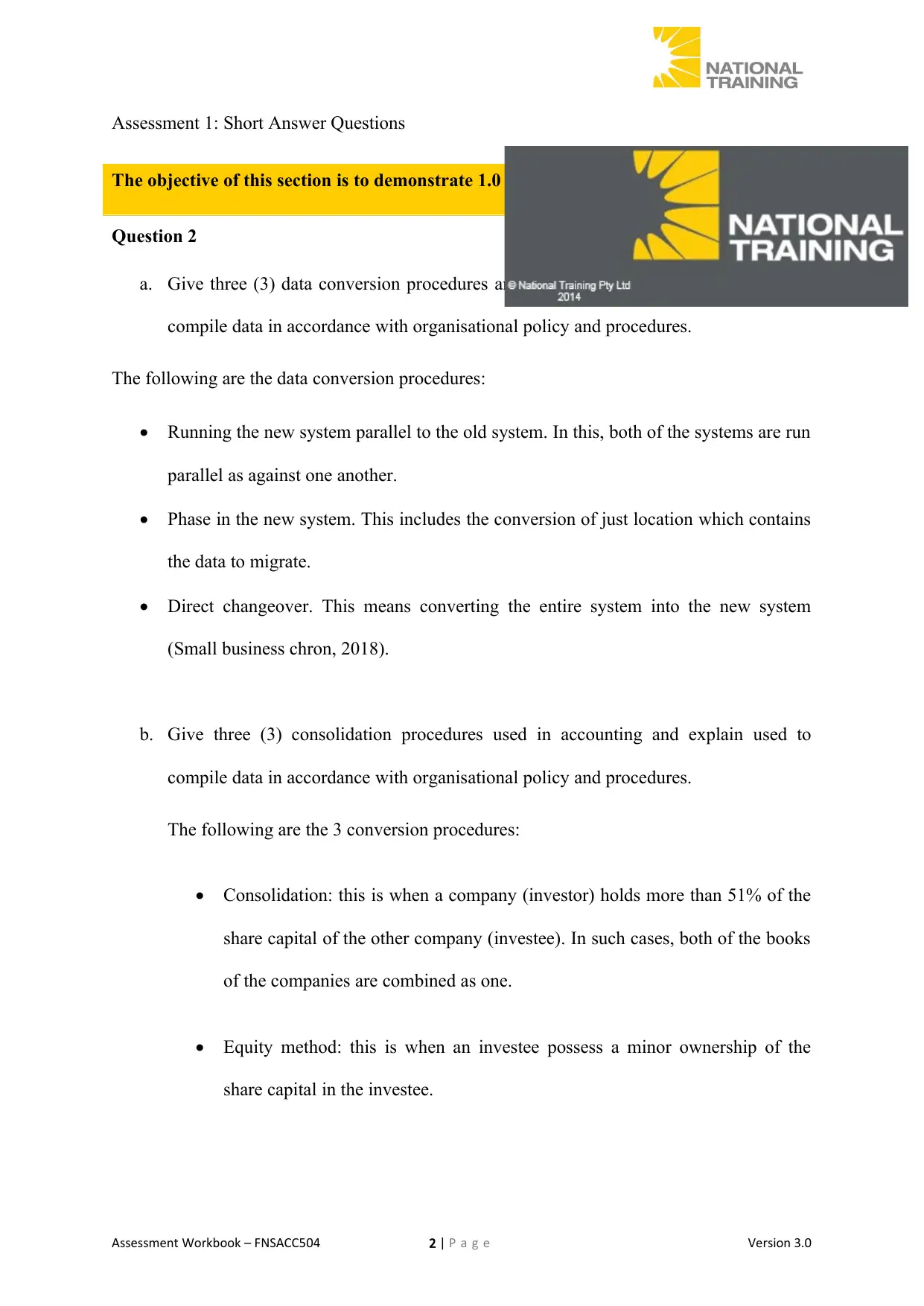
Assessment 1: Short Answer Questions
The objective of this section is to demonstrate 1.0 Compile data
Question 2
a. Give three (3) data conversion procedures and explain when you would use them to
compile data in accordance with organisational policy and procedures.
The following are the data conversion procedures:
Running the new system parallel to the old system. In this, both of the systems are run
parallel as against one another.
Phase in the new system. This includes the conversion of just location which contains
the data to migrate.
Direct changeover. This means converting the entire system into the new system
(Small business chron, 2018).
b. Give three (3) consolidation procedures used in accounting and explain used to
compile data in accordance with organisational policy and procedures.
The following are the 3 conversion procedures:
Consolidation: this is when a company (investor) holds more than 51% of the
share capital of the other company (investee). In such cases, both of the books
of the companies are combined as one.
Equity method: this is when an investee possess a minor ownership of the
share capital in the investee.
Assessment Workbook – FNSACC504 2 | P a g e Version 3.0
The objective of this section is to demonstrate 1.0 Compile data
Question 2
a. Give three (3) data conversion procedures and explain when you would use them to
compile data in accordance with organisational policy and procedures.
The following are the data conversion procedures:
Running the new system parallel to the old system. In this, both of the systems are run
parallel as against one another.
Phase in the new system. This includes the conversion of just location which contains
the data to migrate.
Direct changeover. This means converting the entire system into the new system
(Small business chron, 2018).
b. Give three (3) consolidation procedures used in accounting and explain used to
compile data in accordance with organisational policy and procedures.
The following are the 3 conversion procedures:
Consolidation: this is when a company (investor) holds more than 51% of the
share capital of the other company (investee). In such cases, both of the books
of the companies are combined as one.
Equity method: this is when an investee possess a minor ownership of the
share capital in the investee.
Assessment Workbook – FNSACC504 2 | P a g e Version 3.0
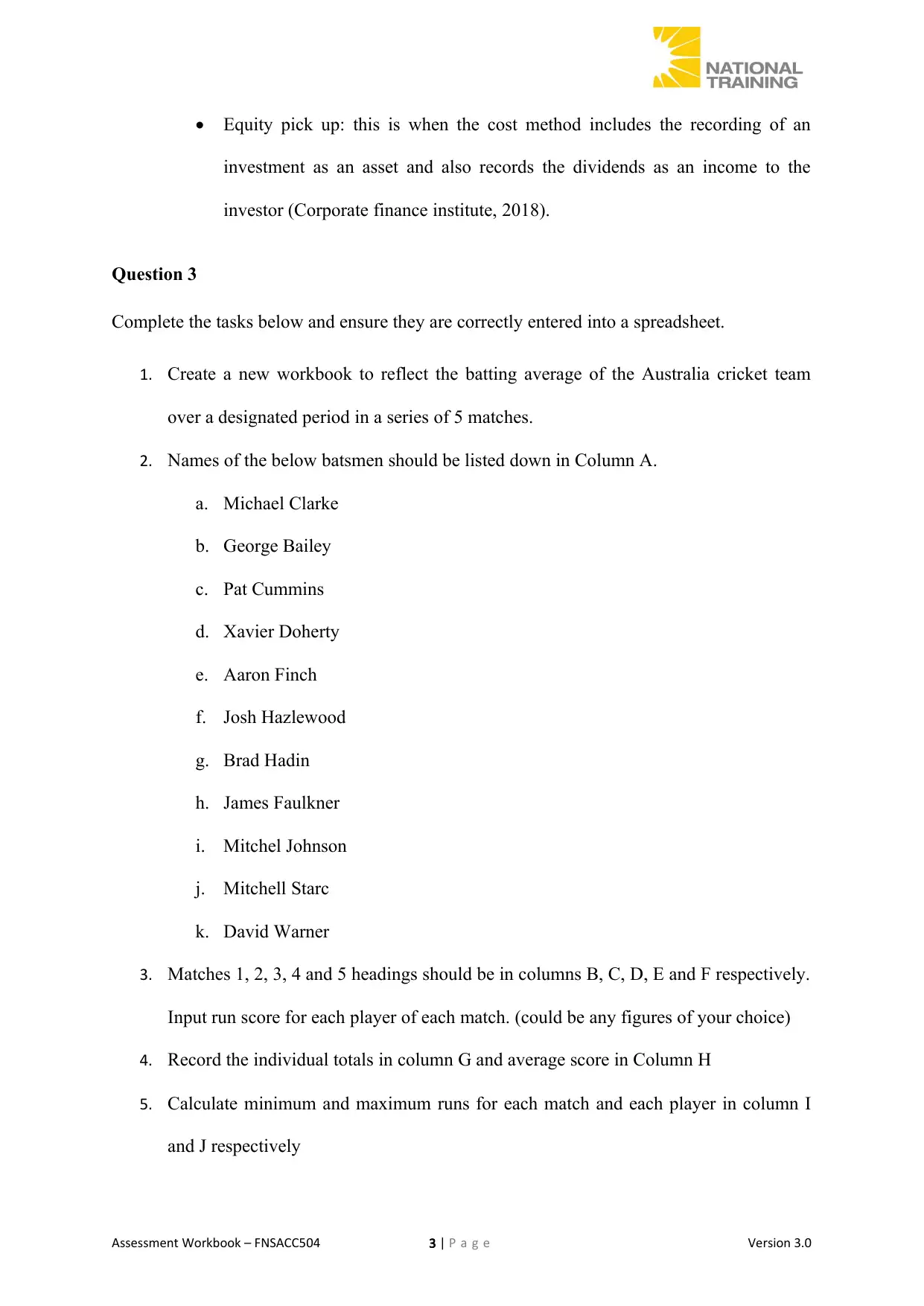
Equity pick up: this is when the cost method includes the recording of an
investment as an asset and also records the dividends as an income to the
investor (Corporate finance institute, 2018).
Question 3
Complete the tasks below and ensure they are correctly entered into a spreadsheet.
1. Create a new workbook to reflect the batting average of the Australia cricket team
over a designated period in a series of 5 matches.
2. Names of the below batsmen should be listed down in Column A.
a. Michael Clarke
b. George Bailey
c. Pat Cummins
d. Xavier Doherty
e. Aaron Finch
f. Josh Hazlewood
g. Brad Hadin
h. James Faulkner
i. Mitchel Johnson
j. Mitchell Starc
k. David Warner
3. Matches 1, 2, 3, 4 and 5 headings should be in columns B, C, D, E and F respectively.
Input run score for each player of each match. (could be any figures of your choice)
4. Record the individual totals in column G and average score in Column H
5. Calculate minimum and maximum runs for each match and each player in column I
and J respectively
Assessment Workbook – FNSACC504 3 | P a g e Version 3.0
investment as an asset and also records the dividends as an income to the
investor (Corporate finance institute, 2018).
Question 3
Complete the tasks below and ensure they are correctly entered into a spreadsheet.
1. Create a new workbook to reflect the batting average of the Australia cricket team
over a designated period in a series of 5 matches.
2. Names of the below batsmen should be listed down in Column A.
a. Michael Clarke
b. George Bailey
c. Pat Cummins
d. Xavier Doherty
e. Aaron Finch
f. Josh Hazlewood
g. Brad Hadin
h. James Faulkner
i. Mitchel Johnson
j. Mitchell Starc
k. David Warner
3. Matches 1, 2, 3, 4 and 5 headings should be in columns B, C, D, E and F respectively.
Input run score for each player of each match. (could be any figures of your choice)
4. Record the individual totals in column G and average score in Column H
5. Calculate minimum and maximum runs for each match and each player in column I
and J respectively
Assessment Workbook – FNSACC504 3 | P a g e Version 3.0

6. Use AutoFill wherever necessary.
7. Present the Match totals in a stacked column Bar chart
8. Add a footer with your name, date and filename.
9. Create a column chart on a new sheet showing the averages, minimums and
maximums for each player.
10. Save the workbook as Activity 3
11. Submit the file in your Moodle
B C D E F G H I J
Column A Matc
h 1
Matc
h 2
Matc
h 3
Matc
h 4
Matc
h 5
Michael
Clarke
47 50 15 20 87 219 43.8 15 87
George
Bailey
52 60 20 46 54 232 46.4 20 60
Pat cummins 64 70 65 64 56 319 63.8 56 70
Xavier
Doherty
15 85 98 89 56 343 68.6 15 98
Aaron Finch 28 15 100 52 24 219 43.8 15 100
Josh
Hazzlewood
14 0 2 25 16 57 11.4 0 25
Brad Hadin 23 10 4 63 17 117 23.4 4 63
Assessment Workbook – FNSACC504 4 | P a g e Version 3.0
7. Present the Match totals in a stacked column Bar chart
8. Add a footer with your name, date and filename.
9. Create a column chart on a new sheet showing the averages, minimums and
maximums for each player.
10. Save the workbook as Activity 3
11. Submit the file in your Moodle
B C D E F G H I J
Column A Matc
h 1
Matc
h 2
Matc
h 3
Matc
h 4
Matc
h 5
Michael
Clarke
47 50 15 20 87 219 43.8 15 87
George
Bailey
52 60 20 46 54 232 46.4 20 60
Pat cummins 64 70 65 64 56 319 63.8 56 70
Xavier
Doherty
15 85 98 89 56 343 68.6 15 98
Aaron Finch 28 15 100 52 24 219 43.8 15 100
Josh
Hazzlewood
14 0 2 25 16 57 11.4 0 25
Brad Hadin 23 10 4 63 17 117 23.4 4 63
Assessment Workbook – FNSACC504 4 | P a g e Version 3.0
Secure Best Marks with AI Grader
Need help grading? Try our AI Grader for instant feedback on your assignments.
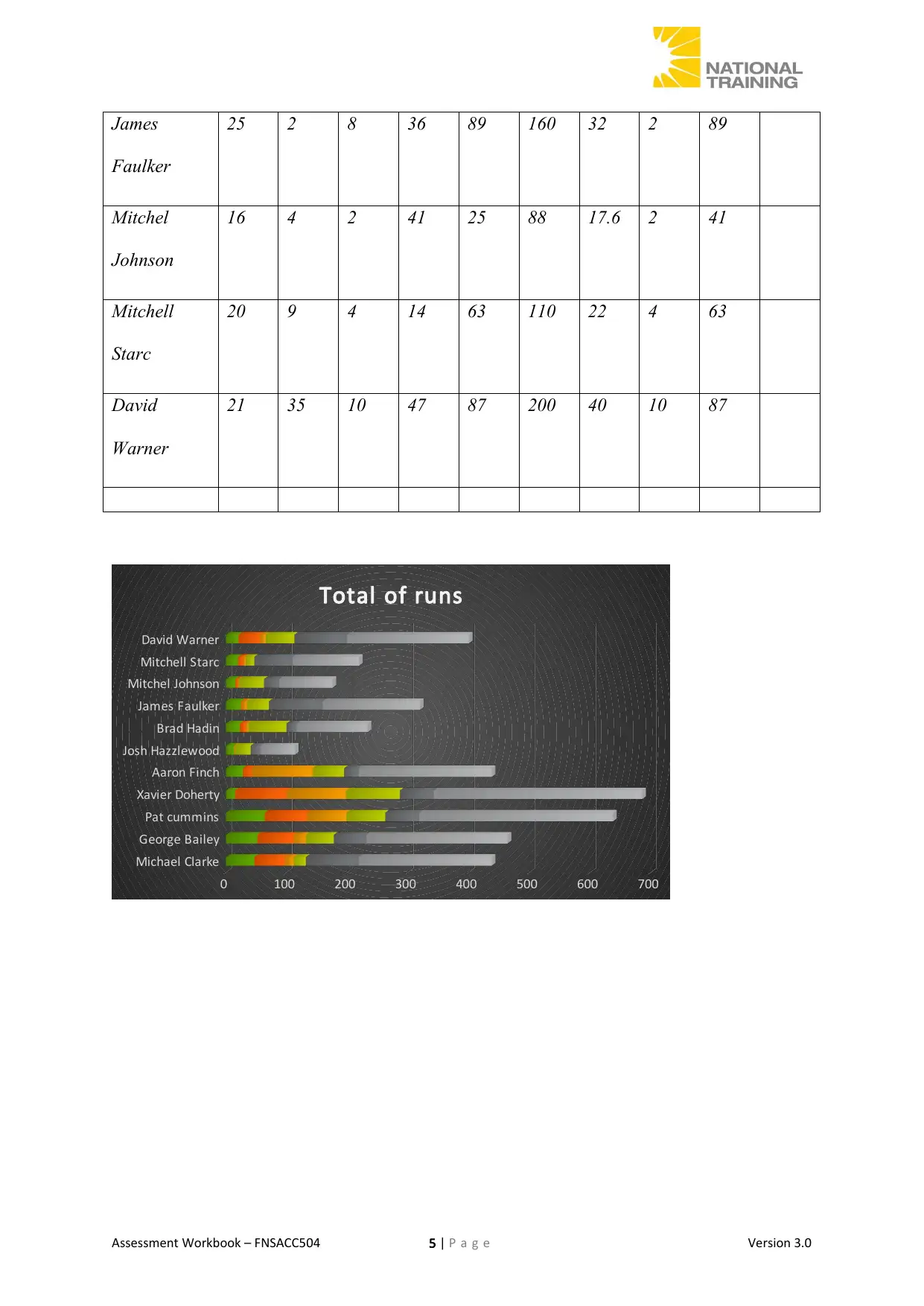
James
Faulker
25 2 8 36 89 160 32 2 89
Mitchel
Johnson
16 4 2 41 25 88 17.6 2 41
Mitchell
Starc
20 9 4 14 63 110 22 4 63
David
Warner
21 35 10 47 87 200 40 10 87
Michael Clarke
George Bailey
Pat cummins
Xavier Doherty
Aaron Finch
Josh Hazzlewood
Brad Hadin
James Faulker
Mitchel Johnson
Mitchell Starc
David Warner
0 100 200 300 400 500 600 700
Total of runs
Assessment Workbook – FNSACC504 5 | P a g e Version 3.0
Faulker
25 2 8 36 89 160 32 2 89
Mitchel
Johnson
16 4 2 41 25 88 17.6 2 41
Mitchell
Starc
20 9 4 14 63 110 22 4 63
David
Warner
21 35 10 47 87 200 40 10 87
Michael Clarke
George Bailey
Pat cummins
Xavier Doherty
Aaron Finch
Josh Hazzlewood
Brad Hadin
James Faulker
Mitchel Johnson
Mitchell Starc
David Warner
0 100 200 300 400 500 600 700
Total of runs
Assessment Workbook – FNSACC504 5 | P a g e Version 3.0
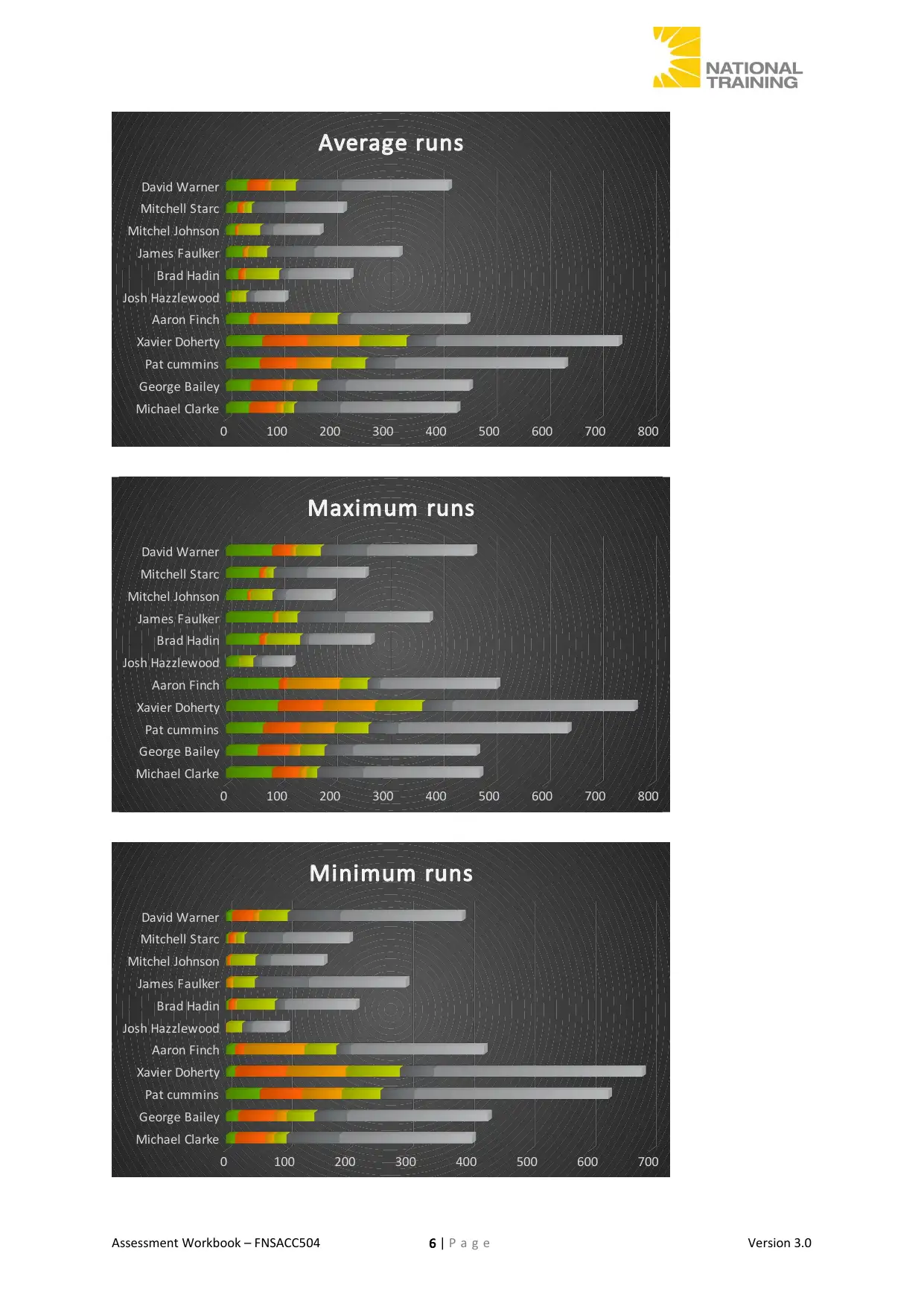
Michael Clarke
George Bailey
Pat cummins
Xavier Doherty
Aaron Finch
Josh Hazzlewood
Brad Hadin
James Faulker
Mitchel Johnson
Mitchell Starc
David Warner
0 100 200 300 400 500 600 700 800
Average runs
Michael Clarke
George Bailey
Pat cummins
Xavier Doherty
Aaron Finch
Josh Hazzlewood
Brad Hadin
James Faulker
Mitchel Johnson
Mitchell Starc
David Warner
0 100 200 300 400 500 600 700 800
Maximum runs
Michael Clarke
George Bailey
Pat cummins
Xavier Doherty
Aaron Finch
Josh Hazzlewood
Brad Hadin
James Faulker
Mitchel Johnson
Mitchell Starc
David Warner
0 100 200 300 400 500 600 700
Minimum runs
Assessment Workbook – FNSACC504 6 | P a g e Version 3.0
George Bailey
Pat cummins
Xavier Doherty
Aaron Finch
Josh Hazzlewood
Brad Hadin
James Faulker
Mitchel Johnson
Mitchell Starc
David Warner
0 100 200 300 400 500 600 700 800
Average runs
Michael Clarke
George Bailey
Pat cummins
Xavier Doherty
Aaron Finch
Josh Hazzlewood
Brad Hadin
James Faulker
Mitchel Johnson
Mitchell Starc
David Warner
0 100 200 300 400 500 600 700 800
Maximum runs
Michael Clarke
George Bailey
Pat cummins
Xavier Doherty
Aaron Finch
Josh Hazzlewood
Brad Hadin
James Faulker
Mitchel Johnson
Mitchell Starc
David Warner
0 100 200 300 400 500 600 700
Minimum runs
Assessment Workbook – FNSACC504 6 | P a g e Version 3.0

Question 4
a. NCT has purchased a new photocopier at a value of $20,000. The purchase was made
on the 1st July 2016 and will be depreciated and written off after 5 years
Using the diminishing value method and the prime cost method, detail the cost each year to
be allocated for reporting purposes and show the book value during each year.
Diminishing value Prime cost
Depreciation Book Value Depreciation Book Value
At Purchase
Year 1
Year 2
Year 3
Year 4
Year 5
b. Use the retail inventory method to calculate the value of ending inventory for an
organisation which has:
I. An opening inventory at cost of $850,000 and a retail value of $2,100,000.
II. Purchases for the year totalled at cost $650,000 and the retail value of the
purchases is $1,000,000.
III. Sales for the year at retail price totalled $2,650,000.
IV. Mark-ups of $80,000 and markdowns of $35,000 during the year.
Diminishing value Prime cost
Assessment Workbook – FNSACC504 7 | P a g e Version 3.0
a. NCT has purchased a new photocopier at a value of $20,000. The purchase was made
on the 1st July 2016 and will be depreciated and written off after 5 years
Using the diminishing value method and the prime cost method, detail the cost each year to
be allocated for reporting purposes and show the book value during each year.
Diminishing value Prime cost
Depreciation Book Value Depreciation Book Value
At Purchase
Year 1
Year 2
Year 3
Year 4
Year 5
b. Use the retail inventory method to calculate the value of ending inventory for an
organisation which has:
I. An opening inventory at cost of $850,000 and a retail value of $2,100,000.
II. Purchases for the year totalled at cost $650,000 and the retail value of the
purchases is $1,000,000.
III. Sales for the year at retail price totalled $2,650,000.
IV. Mark-ups of $80,000 and markdowns of $35,000 during the year.
Diminishing value Prime cost
Assessment Workbook – FNSACC504 7 | P a g e Version 3.0
Paraphrase This Document
Need a fresh take? Get an instant paraphrase of this document with our AI Paraphraser
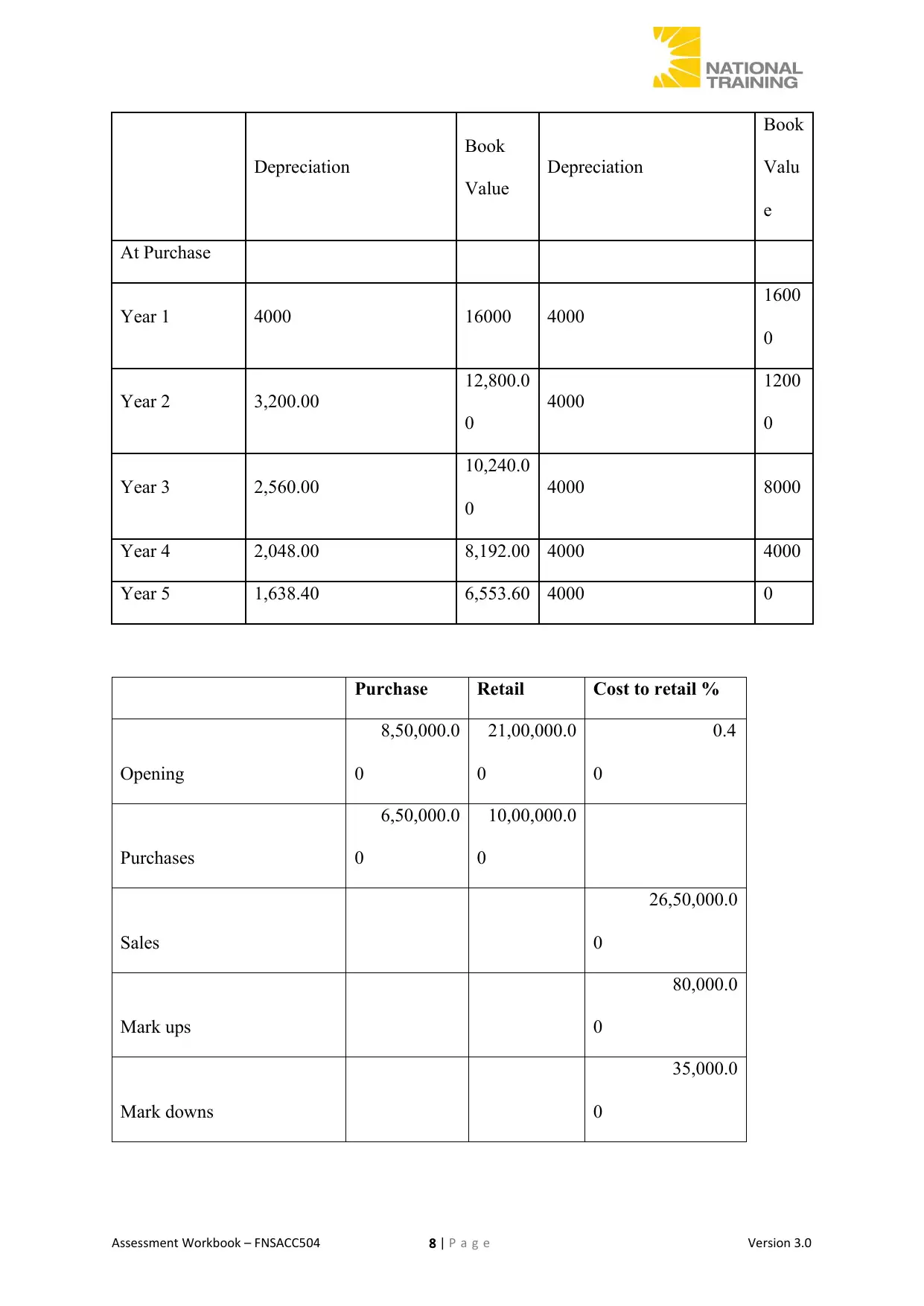
Depreciation
Book
Value
Depreciation
Book
Valu
e
At Purchase
Year 1 4000 16000 4000
1600
0
Year 2 3,200.00
12,800.0
0
4000
1200
0
Year 3 2,560.00
10,240.0
0
4000 8000
Year 4 2,048.00 8,192.00 4000 4000
Year 5 1,638.40 6,553.60 4000 0
Purchase Retail Cost to retail %
Opening
8,50,000.0
0
21,00,000.0
0
0.4
0
Purchases
6,50,000.0
0
10,00,000.0
0
Sales
26,50,000.0
0
Mark ups
80,000.0
0
Mark downs
35,000.0
0
Assessment Workbook – FNSACC504 8 | P a g e Version 3.0
Book
Value
Depreciation
Book
Valu
e
At Purchase
Year 1 4000 16000 4000
1600
0
Year 2 3,200.00
12,800.0
0
4000
1200
0
Year 3 2,560.00
10,240.0
0
4000 8000
Year 4 2,048.00 8,192.00 4000 4000
Year 5 1,638.40 6,553.60 4000 0
Purchase Retail Cost to retail %
Opening
8,50,000.0
0
21,00,000.0
0
0.4
0
Purchases
6,50,000.0
0
10,00,000.0
0
Sales
26,50,000.0
0
Mark ups
80,000.0
0
Mark downs
35,000.0
0
Assessment Workbook – FNSACC504 8 | P a g e Version 3.0
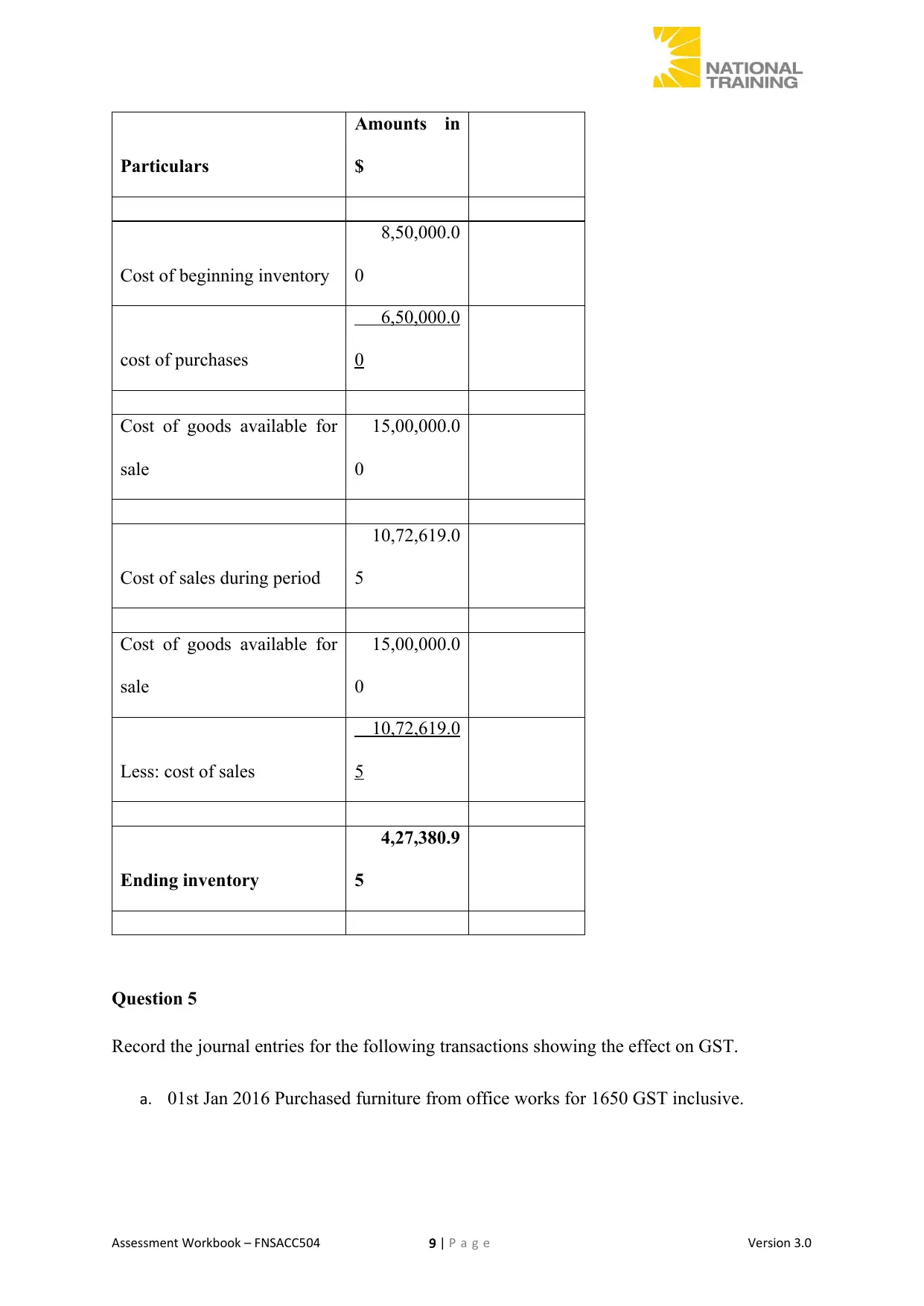
Particulars
Amounts in
$
Cost of beginning inventory
8,50,000.0
0
cost of purchases
6,50,000.0
0
Cost of goods available for
sale
15,00,000.0
0
Cost of sales during period
10,72,619.0
5
Cost of goods available for
sale
15,00,000.0
0
Less: cost of sales
10,72,619.0
5
Ending inventory
4,27,380.9
5
Question 5
Record the journal entries for the following transactions showing the effect on GST.
a. 01st Jan 2016 Purchased furniture from office works for 1650 GST inclusive.
Assessment Workbook – FNSACC504 9 | P a g e Version 3.0
Amounts in
$
Cost of beginning inventory
8,50,000.0
0
cost of purchases
6,50,000.0
0
Cost of goods available for
sale
15,00,000.0
0
Cost of sales during period
10,72,619.0
5
Cost of goods available for
sale
15,00,000.0
0
Less: cost of sales
10,72,619.0
5
Ending inventory
4,27,380.9
5
Question 5
Record the journal entries for the following transactions showing the effect on GST.
a. 01st Jan 2016 Purchased furniture from office works for 1650 GST inclusive.
Assessment Workbook – FNSACC504 9 | P a g e Version 3.0
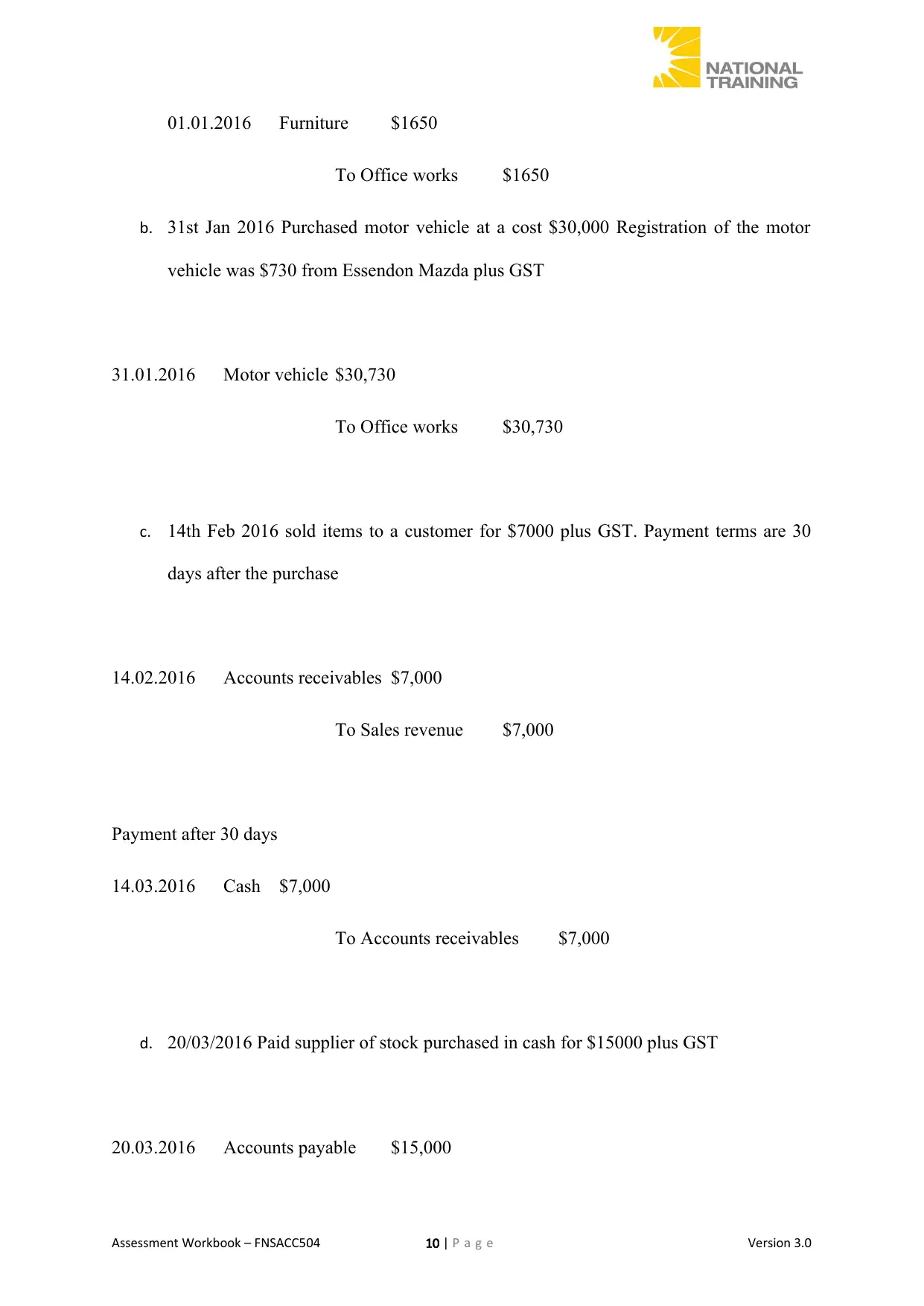
01.01.2016 Furniture $1650
To Office works $1650
b. 31st Jan 2016 Purchased motor vehicle at a cost $30,000 Registration of the motor
vehicle was $730 from Essendon Mazda plus GST
31.01.2016 Motor vehicle $30,730
To Office works $30,730
c. 14th Feb 2016 sold items to a customer for $7000 plus GST. Payment terms are 30
days after the purchase
14.02.2016 Accounts receivables $7,000
To Sales revenue $7,000
Payment after 30 days
14.03.2016 Cash $7,000
To Accounts receivables $7,000
d. 20/03/2016 Paid supplier of stock purchased in cash for $15000 plus GST
20.03.2016 Accounts payable $15,000
Assessment Workbook – FNSACC504 10 | P a g e Version 3.0
To Office works $1650
b. 31st Jan 2016 Purchased motor vehicle at a cost $30,000 Registration of the motor
vehicle was $730 from Essendon Mazda plus GST
31.01.2016 Motor vehicle $30,730
To Office works $30,730
c. 14th Feb 2016 sold items to a customer for $7000 plus GST. Payment terms are 30
days after the purchase
14.02.2016 Accounts receivables $7,000
To Sales revenue $7,000
Payment after 30 days
14.03.2016 Cash $7,000
To Accounts receivables $7,000
d. 20/03/2016 Paid supplier of stock purchased in cash for $15000 plus GST
20.03.2016 Accounts payable $15,000
Assessment Workbook – FNSACC504 10 | P a g e Version 3.0
Secure Best Marks with AI Grader
Need help grading? Try our AI Grader for instant feedback on your assignments.
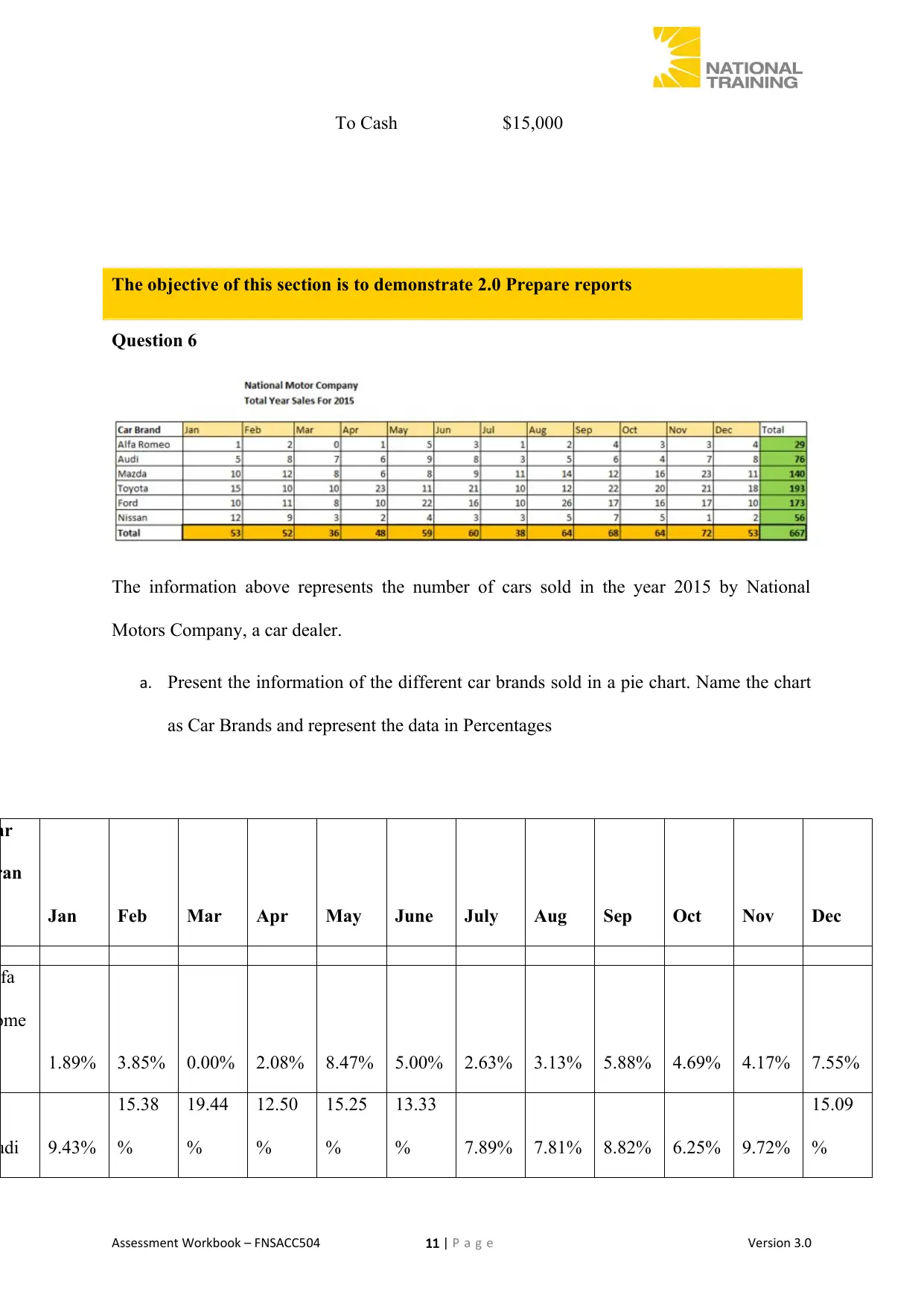
To Cash $15,000
The objective of this section is to demonstrate 2.0 Prepare reports
Question 6
The information above represents the number of cars sold in the year 2015 by National
Motors Company, a car dealer.
a. Present the information of the different car brands sold in a pie chart. Name the chart
as Car Brands and represent the data in Percentages
ar
ran
Jan Feb Mar Apr May June July Aug Sep Oct Nov Dec
lfa
ome
1.89% 3.85% 0.00% 2.08% 8.47% 5.00% 2.63% 3.13% 5.88% 4.69% 4.17% 7.55%
udi 9.43%
15.38
%
19.44
%
12.50
%
15.25
%
13.33
% 7.89% 7.81% 8.82% 6.25% 9.72%
15.09
%
Assessment Workbook – FNSACC504 11 | P a g e Version 3.0
The objective of this section is to demonstrate 2.0 Prepare reports
Question 6
The information above represents the number of cars sold in the year 2015 by National
Motors Company, a car dealer.
a. Present the information of the different car brands sold in a pie chart. Name the chart
as Car Brands and represent the data in Percentages
ar
ran
Jan Feb Mar Apr May June July Aug Sep Oct Nov Dec
lfa
ome
1.89% 3.85% 0.00% 2.08% 8.47% 5.00% 2.63% 3.13% 5.88% 4.69% 4.17% 7.55%
udi 9.43%
15.38
%
19.44
%
12.50
%
15.25
%
13.33
% 7.89% 7.81% 8.82% 6.25% 9.72%
15.09
%
Assessment Workbook – FNSACC504 11 | P a g e Version 3.0
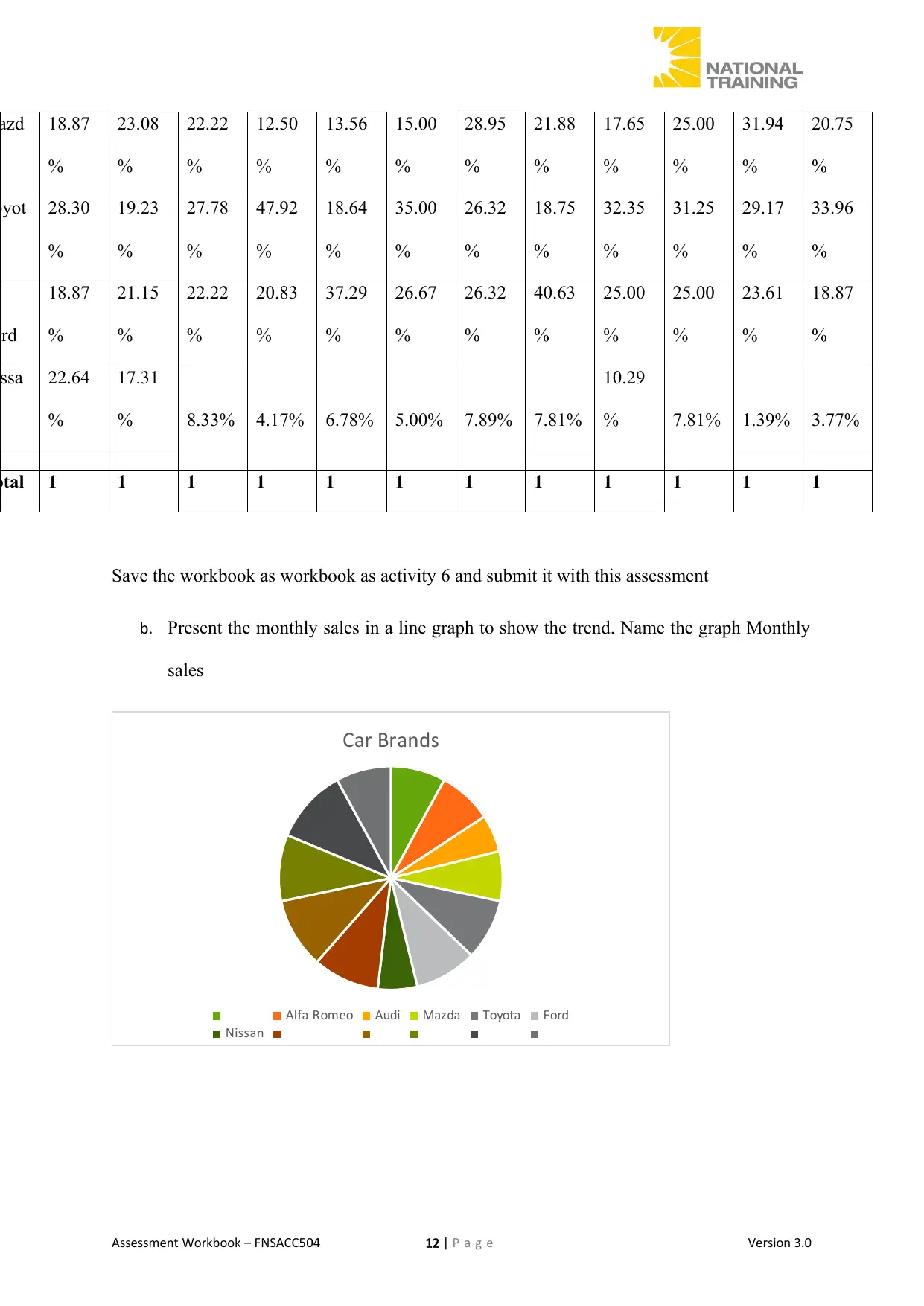
azd 18.87
%
23.08
%
22.22
%
12.50
%
13.56
%
15.00
%
28.95
%
21.88
%
17.65
%
25.00
%
31.94
%
20.75
%
oyot 28.30
%
19.23
%
27.78
%
47.92
%
18.64
%
35.00
%
26.32
%
18.75
%
32.35
%
31.25
%
29.17
%
33.96
%
ord
18.87
%
21.15
%
22.22
%
20.83
%
37.29
%
26.67
%
26.32
%
40.63
%
25.00
%
25.00
%
23.61
%
18.87
%
issa 22.64
%
17.31
% 8.33% 4.17% 6.78% 5.00% 7.89% 7.81%
10.29
% 7.81% 1.39% 3.77%
otal 1 1 1 1 1 1 1 1 1 1 1 1
Save the workbook as workbook as activity 6 and submit it with this assessment
b. Present the monthly sales in a line graph to show the trend. Name the graph Monthly
sales
Car Brands
Alfa Romeo Audi Mazda Toyota Ford
Nissan
Assessment Workbook – FNSACC504 12 | P a g e Version 3.0
%
23.08
%
22.22
%
12.50
%
13.56
%
15.00
%
28.95
%
21.88
%
17.65
%
25.00
%
31.94
%
20.75
%
oyot 28.30
%
19.23
%
27.78
%
47.92
%
18.64
%
35.00
%
26.32
%
18.75
%
32.35
%
31.25
%
29.17
%
33.96
%
ord
18.87
%
21.15
%
22.22
%
20.83
%
37.29
%
26.67
%
26.32
%
40.63
%
25.00
%
25.00
%
23.61
%
18.87
%
issa 22.64
%
17.31
% 8.33% 4.17% 6.78% 5.00% 7.89% 7.81%
10.29
% 7.81% 1.39% 3.77%
otal 1 1 1 1 1 1 1 1 1 1 1 1
Save the workbook as workbook as activity 6 and submit it with this assessment
b. Present the monthly sales in a line graph to show the trend. Name the graph Monthly
sales
Car Brands
Alfa Romeo Audi Mazda Toyota Ford
Nissan
Assessment Workbook – FNSACC504 12 | P a g e Version 3.0
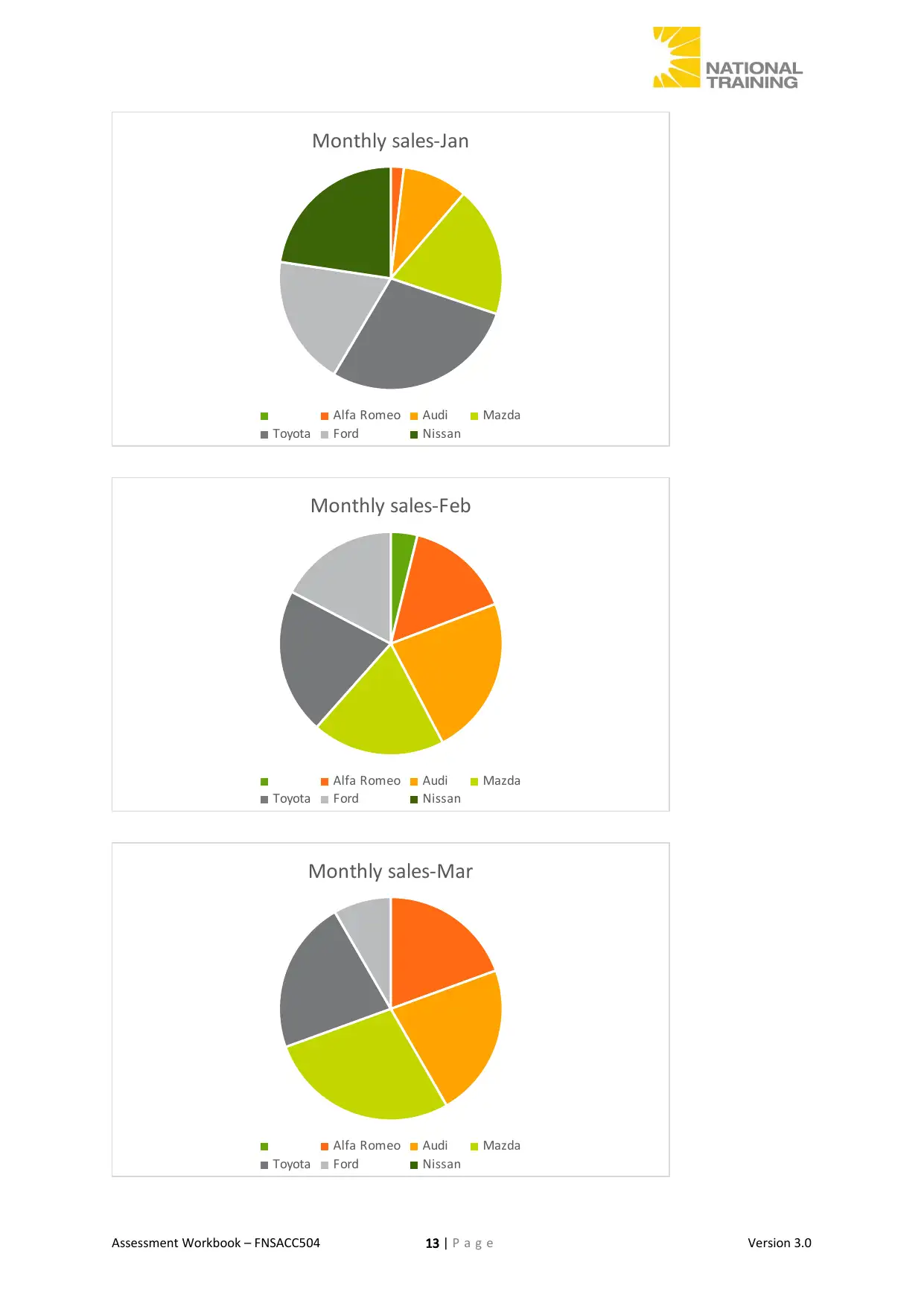
Monthly sales-Jan
Alfa Romeo Audi Mazda
Toyota Ford Nissan
Monthly sales-Feb
Alfa Romeo Audi Mazda
Toyota Ford Nissan
Monthly sales-Mar
Alfa Romeo Audi Mazda
Toyota Ford Nissan
Assessment Workbook – FNSACC504 13 | P a g e Version 3.0
Alfa Romeo Audi Mazda
Toyota Ford Nissan
Monthly sales-Feb
Alfa Romeo Audi Mazda
Toyota Ford Nissan
Monthly sales-Mar
Alfa Romeo Audi Mazda
Toyota Ford Nissan
Assessment Workbook – FNSACC504 13 | P a g e Version 3.0
Paraphrase This Document
Need a fresh take? Get an instant paraphrase of this document with our AI Paraphraser
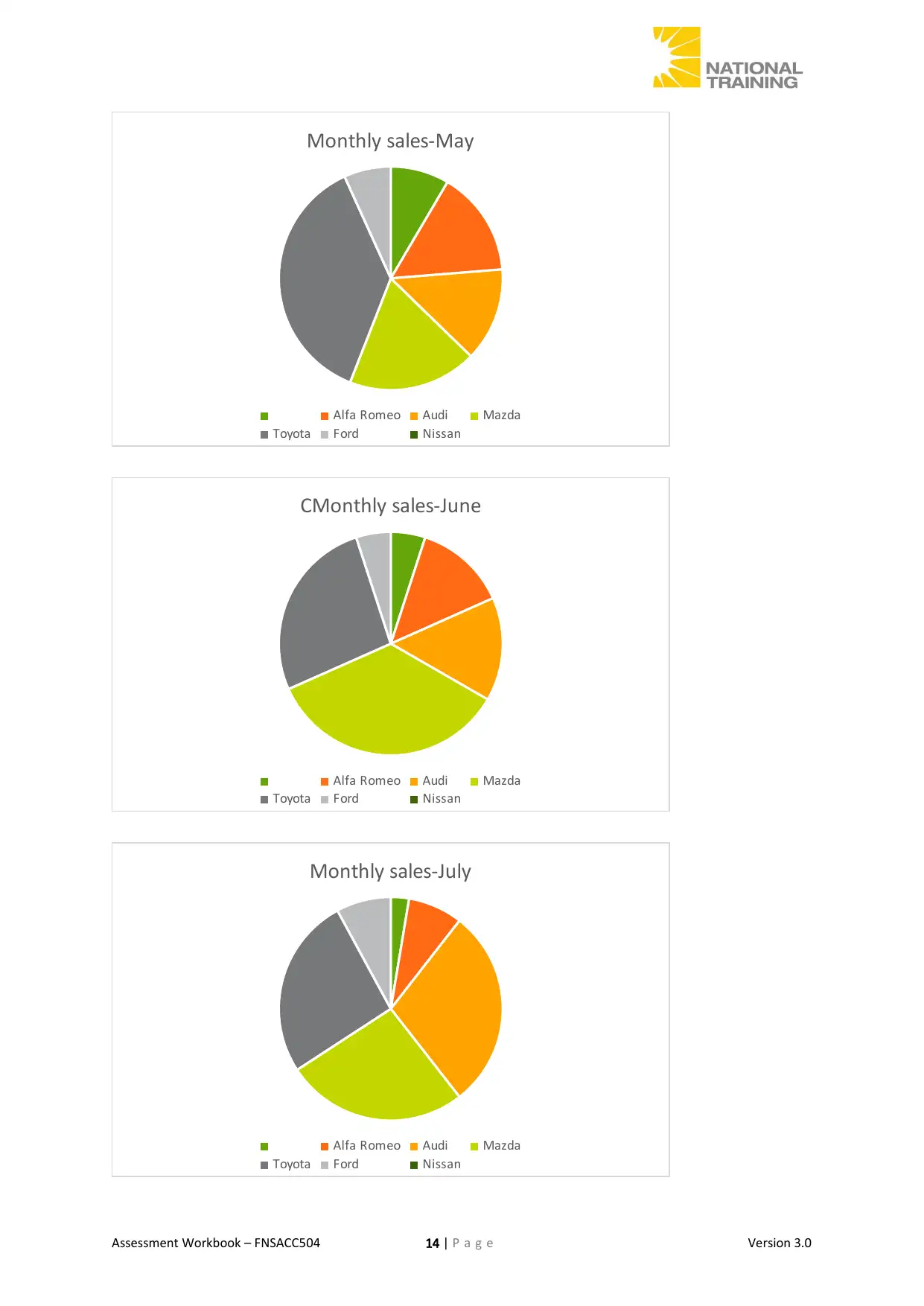
Monthly sales-May
Alfa Romeo Audi Mazda
Toyota Ford Nissan
CMonthly sales-June
Alfa Romeo Audi Mazda
Toyota Ford Nissan
Monthly sales-July
Alfa Romeo Audi Mazda
Toyota Ford Nissan
Assessment Workbook – FNSACC504 14 | P a g e Version 3.0
Alfa Romeo Audi Mazda
Toyota Ford Nissan
CMonthly sales-June
Alfa Romeo Audi Mazda
Toyota Ford Nissan
Monthly sales-July
Alfa Romeo Audi Mazda
Toyota Ford Nissan
Assessment Workbook – FNSACC504 14 | P a g e Version 3.0
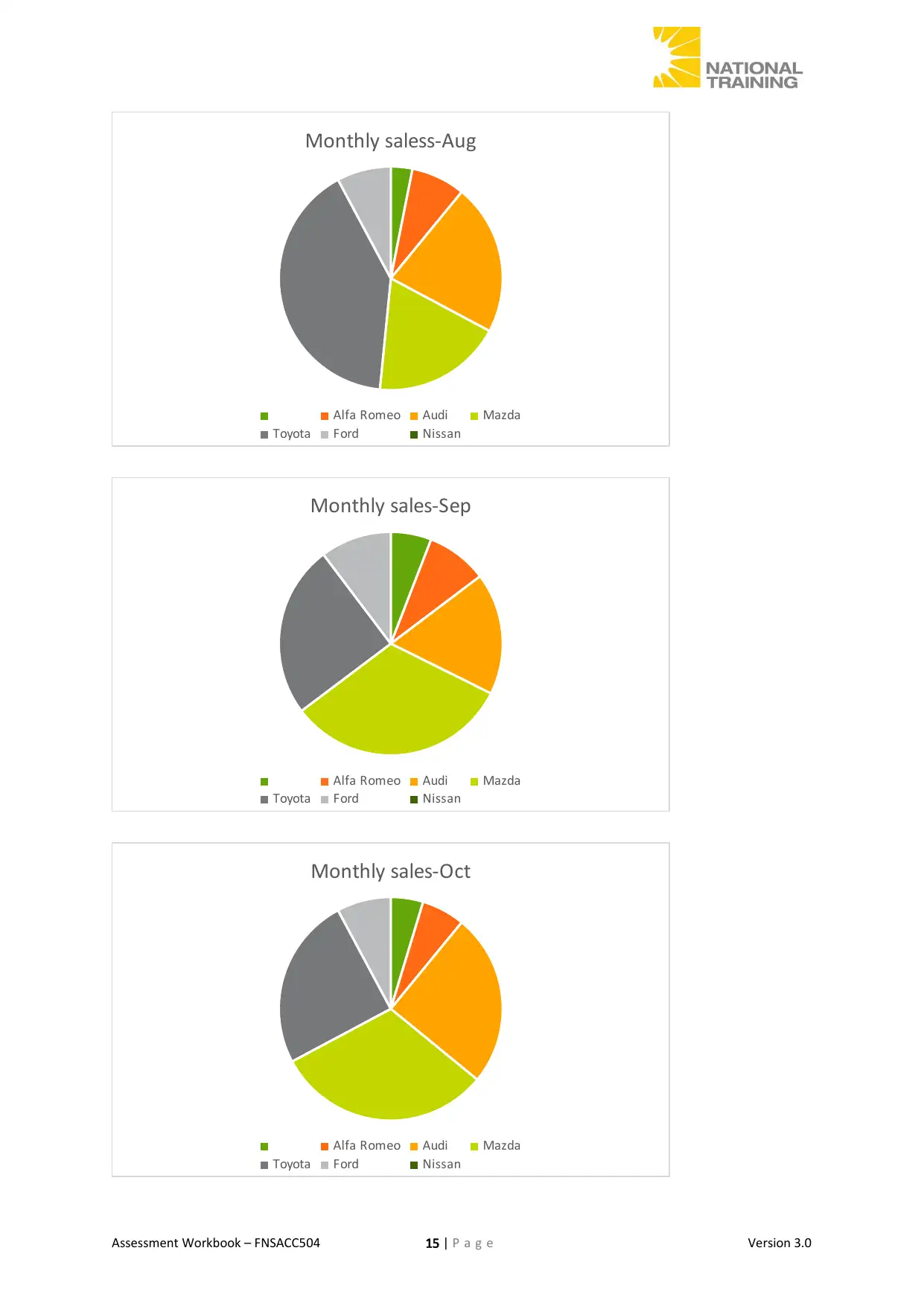
Monthly saless-Aug
Alfa Romeo Audi Mazda
Toyota Ford Nissan
Monthly sales-Sep
Alfa Romeo Audi Mazda
Toyota Ford Nissan
Monthly sales-Oct
Alfa Romeo Audi Mazda
Toyota Ford Nissan
Assessment Workbook – FNSACC504 15 | P a g e Version 3.0
Alfa Romeo Audi Mazda
Toyota Ford Nissan
Monthly sales-Sep
Alfa Romeo Audi Mazda
Toyota Ford Nissan
Monthly sales-Oct
Alfa Romeo Audi Mazda
Toyota Ford Nissan
Assessment Workbook – FNSACC504 15 | P a g e Version 3.0
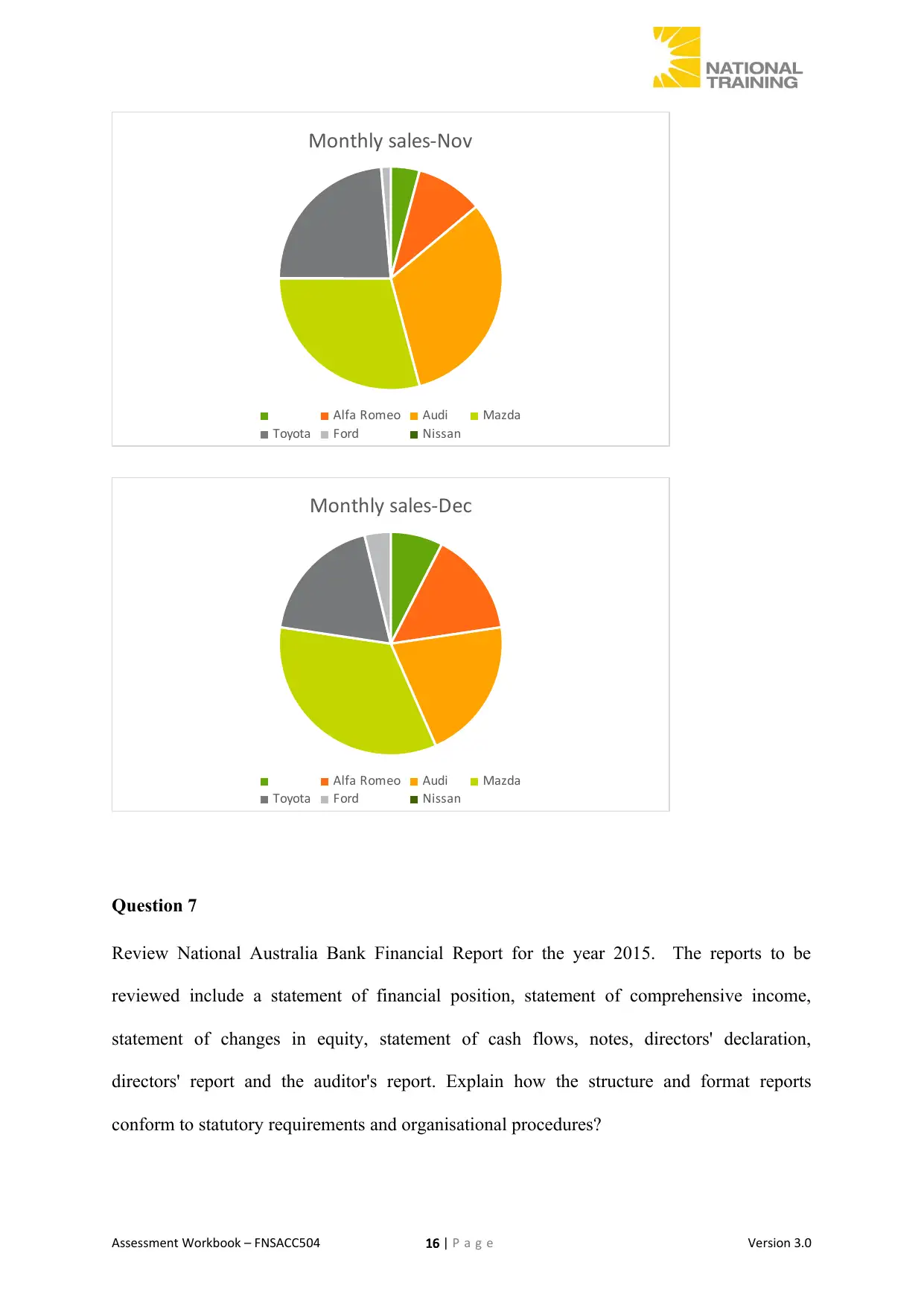
Monthly sales-Nov
Alfa Romeo Audi Mazda
Toyota Ford Nissan
Monthly sales-Dec
Alfa Romeo Audi Mazda
Toyota Ford Nissan
Question 7
Review National Australia Bank Financial Report for the year 2015. The reports to be
reviewed include a statement of financial position, statement of comprehensive income,
statement of changes in equity, statement of cash flows, notes, directors' declaration,
directors' report and the auditor's report. Explain how the structure and format reports
conform to statutory requirements and organisational procedures?
Assessment Workbook – FNSACC504 16 | P a g e Version 3.0
Alfa Romeo Audi Mazda
Toyota Ford Nissan
Monthly sales-Dec
Alfa Romeo Audi Mazda
Toyota Ford Nissan
Question 7
Review National Australia Bank Financial Report for the year 2015. The reports to be
reviewed include a statement of financial position, statement of comprehensive income,
statement of changes in equity, statement of cash flows, notes, directors' declaration,
directors' report and the auditor's report. Explain how the structure and format reports
conform to statutory requirements and organisational procedures?
Assessment Workbook – FNSACC504 16 | P a g e Version 3.0
Secure Best Marks with AI Grader
Need help grading? Try our AI Grader for instant feedback on your assignments.
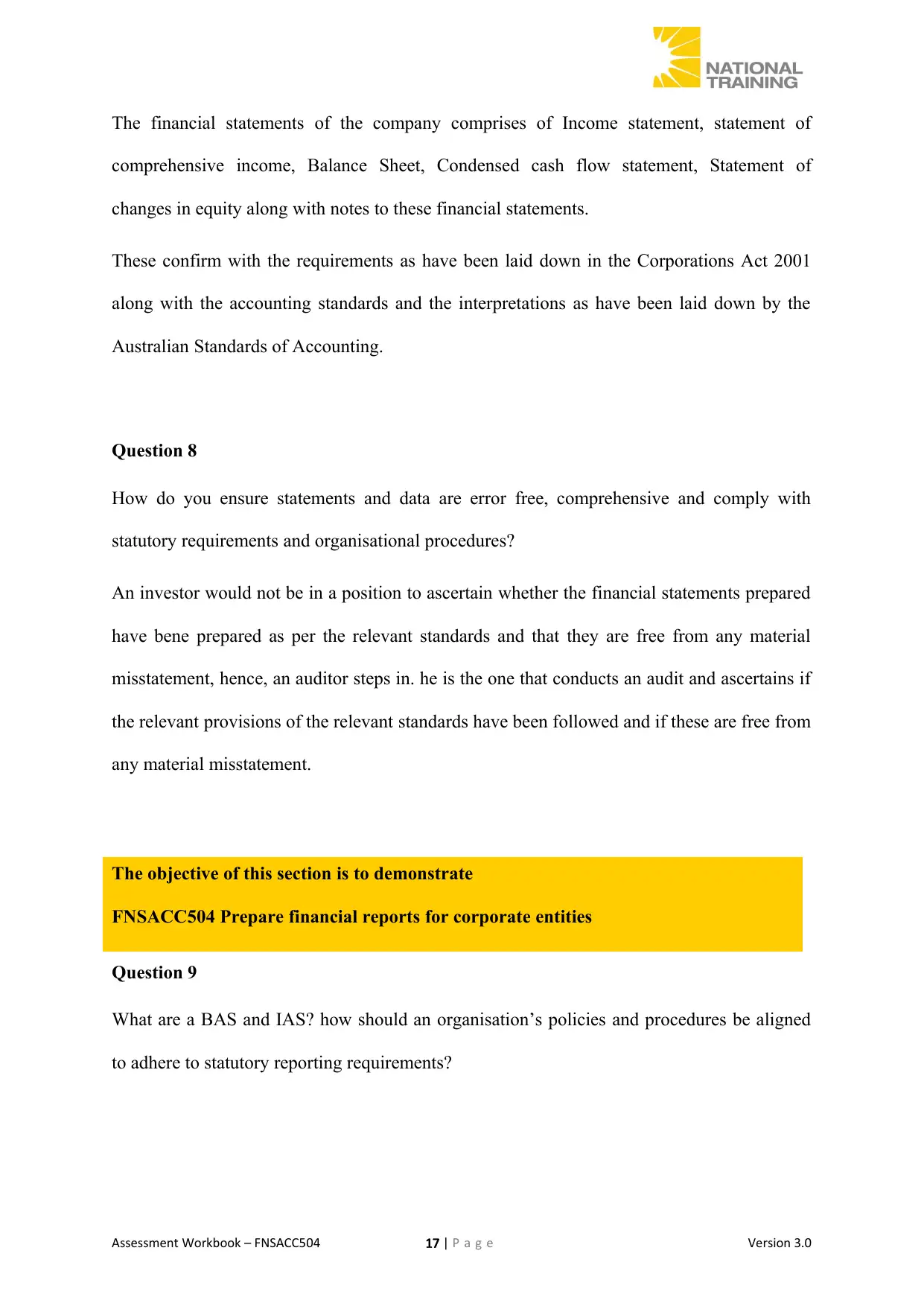
The financial statements of the company comprises of Income statement, statement of
comprehensive income, Balance Sheet, Condensed cash flow statement, Statement of
changes in equity along with notes to these financial statements.
These confirm with the requirements as have been laid down in the Corporations Act 2001
along with the accounting standards and the interpretations as have been laid down by the
Australian Standards of Accounting.
Question 8
How do you ensure statements and data are error free, comprehensive and comply with
statutory requirements and organisational procedures?
An investor would not be in a position to ascertain whether the financial statements prepared
have bene prepared as per the relevant standards and that they are free from any material
misstatement, hence, an auditor steps in. he is the one that conducts an audit and ascertains if
the relevant provisions of the relevant standards have been followed and if these are free from
any material misstatement.
The objective of this section is to demonstrate
FNSACC504 Prepare financial reports for corporate entities
Question 9
What are a BAS and IAS? how should an organisation’s policies and procedures be aligned
to adhere to statutory reporting requirements?
Assessment Workbook – FNSACC504 17 | P a g e Version 3.0
comprehensive income, Balance Sheet, Condensed cash flow statement, Statement of
changes in equity along with notes to these financial statements.
These confirm with the requirements as have been laid down in the Corporations Act 2001
along with the accounting standards and the interpretations as have been laid down by the
Australian Standards of Accounting.
Question 8
How do you ensure statements and data are error free, comprehensive and comply with
statutory requirements and organisational procedures?
An investor would not be in a position to ascertain whether the financial statements prepared
have bene prepared as per the relevant standards and that they are free from any material
misstatement, hence, an auditor steps in. he is the one that conducts an audit and ascertains if
the relevant provisions of the relevant standards have been followed and if these are free from
any material misstatement.
The objective of this section is to demonstrate
FNSACC504 Prepare financial reports for corporate entities
Question 9
What are a BAS and IAS? how should an organisation’s policies and procedures be aligned
to adhere to statutory reporting requirements?
Assessment Workbook – FNSACC504 17 | P a g e Version 3.0

These are the activity statements that are lodged with an ATO. There are mainly 2 types of
statements, one being a business activity statement and the other being an instalment activity
statement.
Any company must keep of all of the relevant transactions that have been entered during the
current year in the most utmost efficient way (Rozhaley, 2018).
Question 10
Some of the ethical issues that the board of Governance in an organisation face are conflict of
interest, confidentiality and disclosure requirements. Explain how the above ethical issues
could be resolved or avoided.
There are some of the ethical issues that the board of directors face when it comes to carrying
of the duties. These are solved by appointing an independent director in the board. There is a
specific composition of the board of directors. This is due to the reason that there are some of
the conflicts of interest that only and independent director could solve since he is not
associated with any of the parties.
Assessment 2: Project
The objective of this section is to demonstrate
FNSACC504 Prepare financial reports for corporate entities
Project
Research the NAB Annual Financial report for 2015. Prepare a report 2000 words answering
these questions:
Question 1
To whom is this report disseminated and how does this take place?
Assessment Workbook – FNSACC504 18 | P a g e Version 3.0
statements, one being a business activity statement and the other being an instalment activity
statement.
Any company must keep of all of the relevant transactions that have been entered during the
current year in the most utmost efficient way (Rozhaley, 2018).
Question 10
Some of the ethical issues that the board of Governance in an organisation face are conflict of
interest, confidentiality and disclosure requirements. Explain how the above ethical issues
could be resolved or avoided.
There are some of the ethical issues that the board of directors face when it comes to carrying
of the duties. These are solved by appointing an independent director in the board. There is a
specific composition of the board of directors. This is due to the reason that there are some of
the conflicts of interest that only and independent director could solve since he is not
associated with any of the parties.
Assessment 2: Project
The objective of this section is to demonstrate
FNSACC504 Prepare financial reports for corporate entities
Project
Research the NAB Annual Financial report for 2015. Prepare a report 2000 words answering
these questions:
Question 1
To whom is this report disseminated and how does this take place?
Assessment Workbook – FNSACC504 18 | P a g e Version 3.0

The annual report of the company is addressed to the shareholders of the company and the
annual report is circulated amongst the shareholders. And any issues and the profitability of
the company are discussed in the shareholders meeting.
Question 2
Why might these recipients need or want the information contained in the annual report?
There are many users of these financial statements which have been listed below:
The management of the company uses these reports to ascertain the profitability,
liquidity along with the cash flows of the company each and every month.
The competitors of the company uses these statements which are competing as against
the business so that they are able to gain an access to the financial statements. The
competitors use this information for the purposes of evaluating the financial
conditions of its rivals.
The customers. The customers need this information to know the financial ability of
the supplier to remain in the business sin the near future and whether the company
would be able to provide enough goods or the services as are required in the stated
contract.
The employees. They need to know the facts that are contained in the documents. This
could be used for the purposes of increasing the level of engagement and
understanding of an employee.
The government. This is used for the purposes of determining the amounts of the
taxes that are paid by the company
Assessment Workbook – FNSACC504 19 | P a g e Version 3.0
annual report is circulated amongst the shareholders. And any issues and the profitability of
the company are discussed in the shareholders meeting.
Question 2
Why might these recipients need or want the information contained in the annual report?
There are many users of these financial statements which have been listed below:
The management of the company uses these reports to ascertain the profitability,
liquidity along with the cash flows of the company each and every month.
The competitors of the company uses these statements which are competing as against
the business so that they are able to gain an access to the financial statements. The
competitors use this information for the purposes of evaluating the financial
conditions of its rivals.
The customers. The customers need this information to know the financial ability of
the supplier to remain in the business sin the near future and whether the company
would be able to provide enough goods or the services as are required in the stated
contract.
The employees. They need to know the facts that are contained in the documents. This
could be used for the purposes of increasing the level of engagement and
understanding of an employee.
The government. This is used for the purposes of determining the amounts of the
taxes that are paid by the company
Assessment Workbook – FNSACC504 19 | P a g e Version 3.0
Paraphrase This Document
Need a fresh take? Get an instant paraphrase of this document with our AI Paraphraser
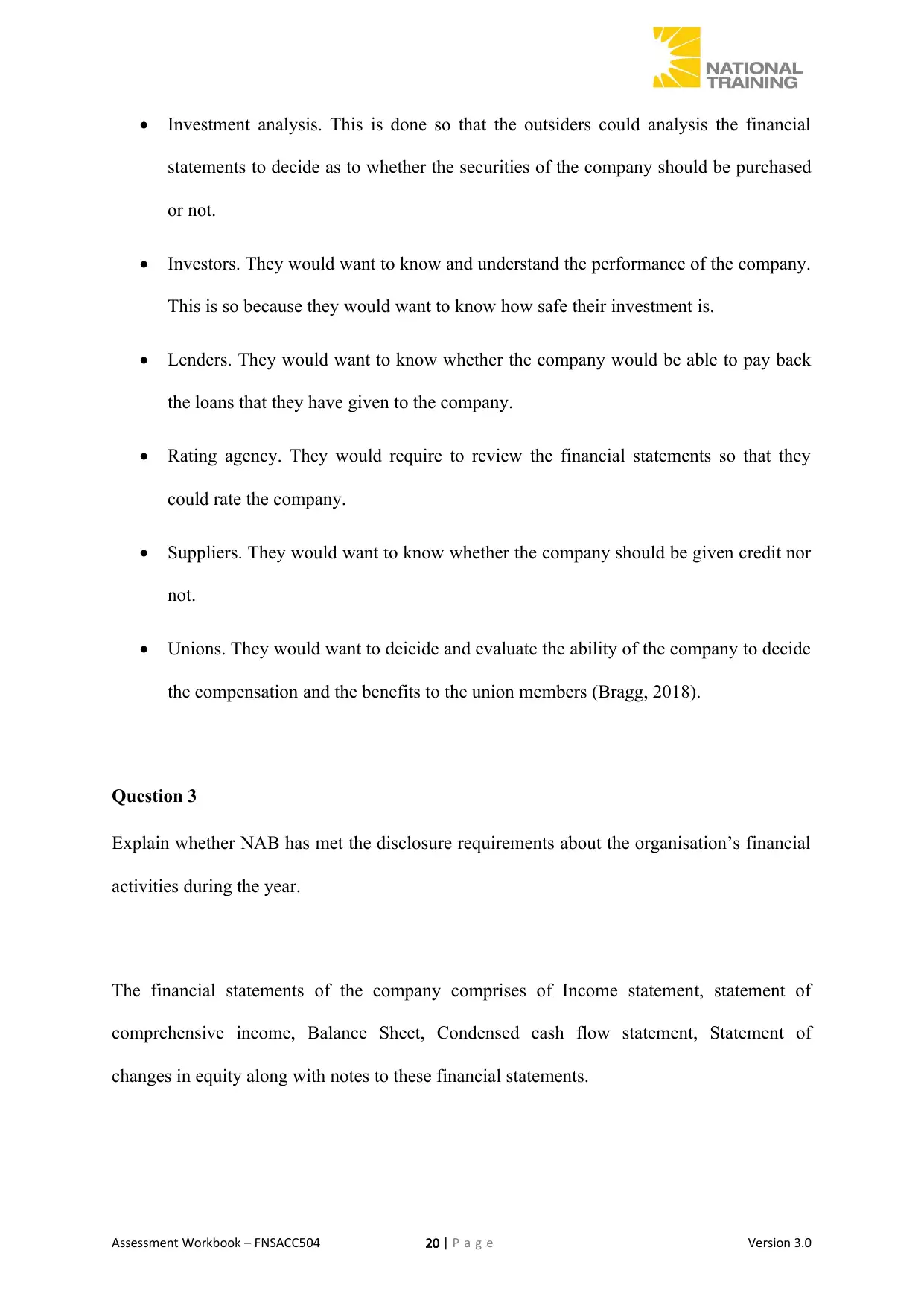
Investment analysis. This is done so that the outsiders could analysis the financial
statements to decide as to whether the securities of the company should be purchased
or not.
Investors. They would want to know and understand the performance of the company.
This is so because they would want to know how safe their investment is.
Lenders. They would want to know whether the company would be able to pay back
the loans that they have given to the company.
Rating agency. They would require to review the financial statements so that they
could rate the company.
Suppliers. They would want to know whether the company should be given credit nor
not.
Unions. They would want to deicide and evaluate the ability of the company to decide
the compensation and the benefits to the union members (Bragg, 2018).
Question 3
Explain whether NAB has met the disclosure requirements about the organisation’s financial
activities during the year.
The financial statements of the company comprises of Income statement, statement of
comprehensive income, Balance Sheet, Condensed cash flow statement, Statement of
changes in equity along with notes to these financial statements.
Assessment Workbook – FNSACC504 20 | P a g e Version 3.0
statements to decide as to whether the securities of the company should be purchased
or not.
Investors. They would want to know and understand the performance of the company.
This is so because they would want to know how safe their investment is.
Lenders. They would want to know whether the company would be able to pay back
the loans that they have given to the company.
Rating agency. They would require to review the financial statements so that they
could rate the company.
Suppliers. They would want to know whether the company should be given credit nor
not.
Unions. They would want to deicide and evaluate the ability of the company to decide
the compensation and the benefits to the union members (Bragg, 2018).
Question 3
Explain whether NAB has met the disclosure requirements about the organisation’s financial
activities during the year.
The financial statements of the company comprises of Income statement, statement of
comprehensive income, Balance Sheet, Condensed cash flow statement, Statement of
changes in equity along with notes to these financial statements.
Assessment Workbook – FNSACC504 20 | P a g e Version 3.0
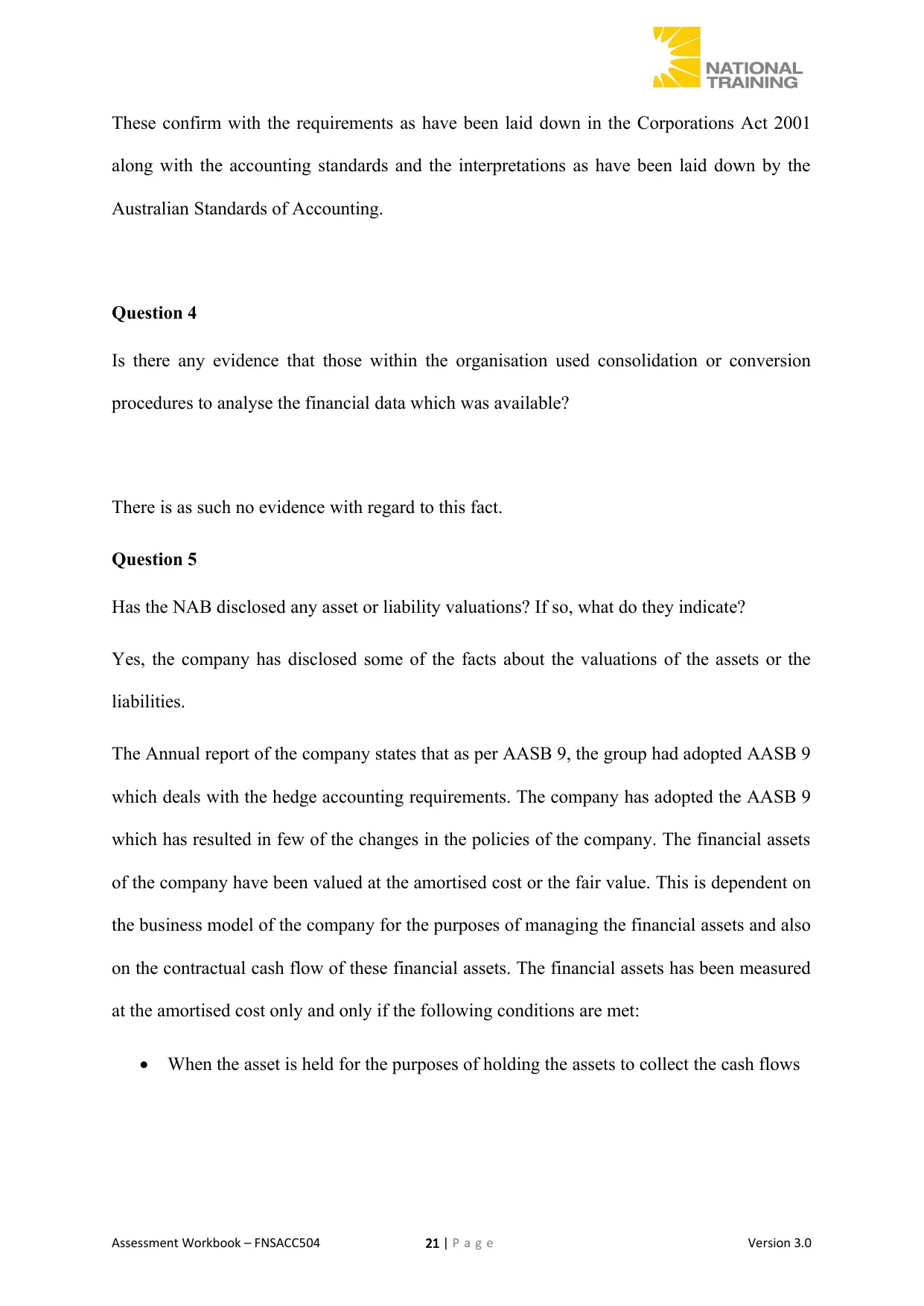
These confirm with the requirements as have been laid down in the Corporations Act 2001
along with the accounting standards and the interpretations as have been laid down by the
Australian Standards of Accounting.
Question 4
Is there any evidence that those within the organisation used consolidation or conversion
procedures to analyse the financial data which was available?
There is as such no evidence with regard to this fact.
Question 5
Has the NAB disclosed any asset or liability valuations? If so, what do they indicate?
Yes, the company has disclosed some of the facts about the valuations of the assets or the
liabilities.
The Annual report of the company states that as per AASB 9, the group had adopted AASB 9
which deals with the hedge accounting requirements. The company has adopted the AASB 9
which has resulted in few of the changes in the policies of the company. The financial assets
of the company have been valued at the amortised cost or the fair value. This is dependent on
the business model of the company for the purposes of managing the financial assets and also
on the contractual cash flow of these financial assets. The financial assets has been measured
at the amortised cost only and only if the following conditions are met:
When the asset is held for the purposes of holding the assets to collect the cash flows
Assessment Workbook – FNSACC504 21 | P a g e Version 3.0
along with the accounting standards and the interpretations as have been laid down by the
Australian Standards of Accounting.
Question 4
Is there any evidence that those within the organisation used consolidation or conversion
procedures to analyse the financial data which was available?
There is as such no evidence with regard to this fact.
Question 5
Has the NAB disclosed any asset or liability valuations? If so, what do they indicate?
Yes, the company has disclosed some of the facts about the valuations of the assets or the
liabilities.
The Annual report of the company states that as per AASB 9, the group had adopted AASB 9
which deals with the hedge accounting requirements. The company has adopted the AASB 9
which has resulted in few of the changes in the policies of the company. The financial assets
of the company have been valued at the amortised cost or the fair value. This is dependent on
the business model of the company for the purposes of managing the financial assets and also
on the contractual cash flow of these financial assets. The financial assets has been measured
at the amortised cost only and only if the following conditions are met:
When the asset is held for the purposes of holding the assets to collect the cash flows
Assessment Workbook – FNSACC504 21 | P a g e Version 3.0
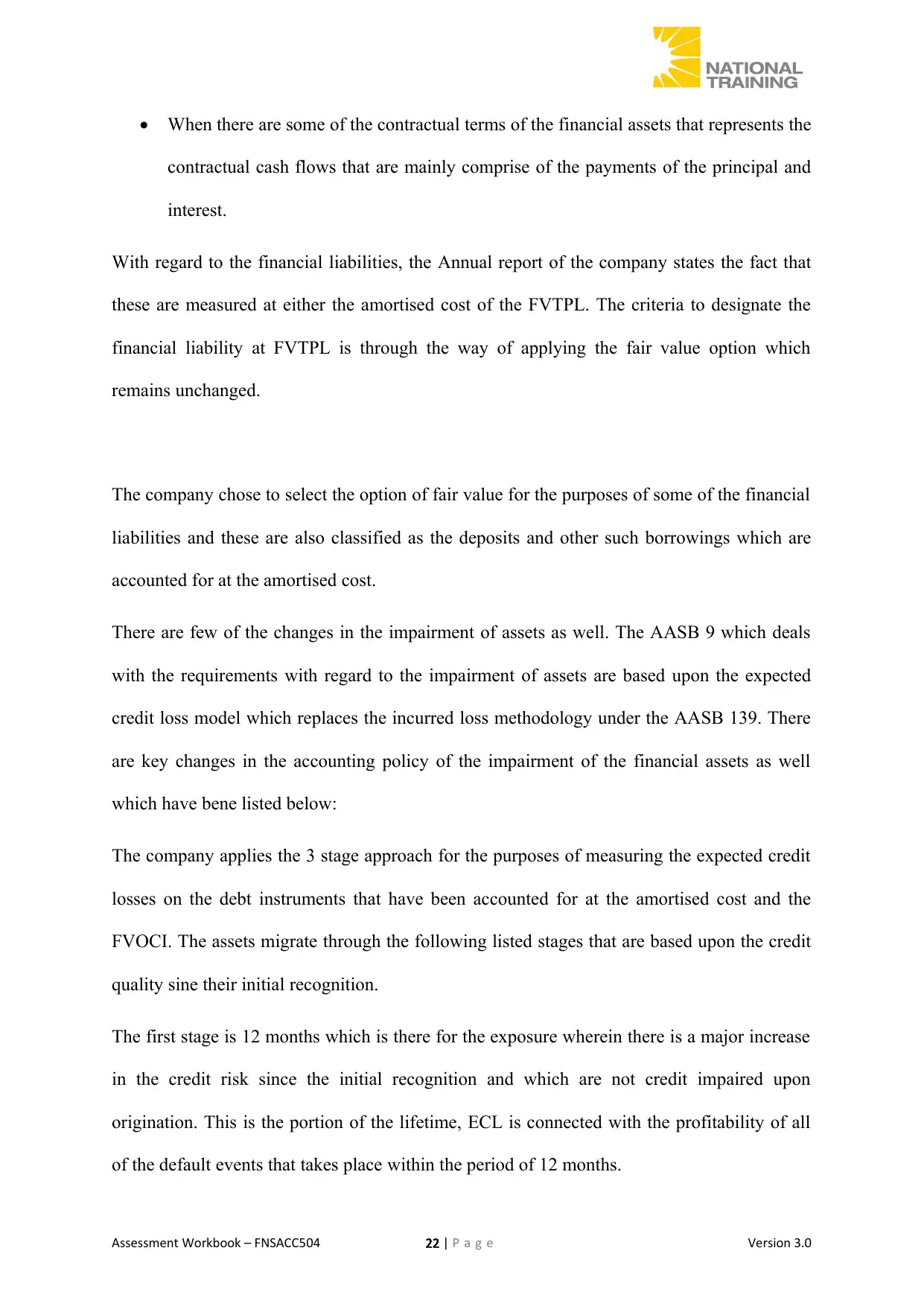
When there are some of the contractual terms of the financial assets that represents the
contractual cash flows that are mainly comprise of the payments of the principal and
interest.
With regard to the financial liabilities, the Annual report of the company states the fact that
these are measured at either the amortised cost of the FVTPL. The criteria to designate the
financial liability at FVTPL is through the way of applying the fair value option which
remains unchanged.
The company chose to select the option of fair value for the purposes of some of the financial
liabilities and these are also classified as the deposits and other such borrowings which are
accounted for at the amortised cost.
There are few of the changes in the impairment of assets as well. The AASB 9 which deals
with the requirements with regard to the impairment of assets are based upon the expected
credit loss model which replaces the incurred loss methodology under the AASB 139. There
are key changes in the accounting policy of the impairment of the financial assets as well
which have bene listed below:
The company applies the 3 stage approach for the purposes of measuring the expected credit
losses on the debt instruments that have been accounted for at the amortised cost and the
FVOCI. The assets migrate through the following listed stages that are based upon the credit
quality sine their initial recognition.
The first stage is 12 months which is there for the exposure wherein there is a major increase
in the credit risk since the initial recognition and which are not credit impaired upon
origination. This is the portion of the lifetime, ECL is connected with the profitability of all
of the default events that takes place within the period of 12 months.
Assessment Workbook – FNSACC504 22 | P a g e Version 3.0
contractual cash flows that are mainly comprise of the payments of the principal and
interest.
With regard to the financial liabilities, the Annual report of the company states the fact that
these are measured at either the amortised cost of the FVTPL. The criteria to designate the
financial liability at FVTPL is through the way of applying the fair value option which
remains unchanged.
The company chose to select the option of fair value for the purposes of some of the financial
liabilities and these are also classified as the deposits and other such borrowings which are
accounted for at the amortised cost.
There are few of the changes in the impairment of assets as well. The AASB 9 which deals
with the requirements with regard to the impairment of assets are based upon the expected
credit loss model which replaces the incurred loss methodology under the AASB 139. There
are key changes in the accounting policy of the impairment of the financial assets as well
which have bene listed below:
The company applies the 3 stage approach for the purposes of measuring the expected credit
losses on the debt instruments that have been accounted for at the amortised cost and the
FVOCI. The assets migrate through the following listed stages that are based upon the credit
quality sine their initial recognition.
The first stage is 12 months which is there for the exposure wherein there is a major increase
in the credit risk since the initial recognition and which are not credit impaired upon
origination. This is the portion of the lifetime, ECL is connected with the profitability of all
of the default events that takes place within the period of 12 months.
Assessment Workbook – FNSACC504 22 | P a g e Version 3.0
Secure Best Marks with AI Grader
Need help grading? Try our AI Grader for instant feedback on your assignments.
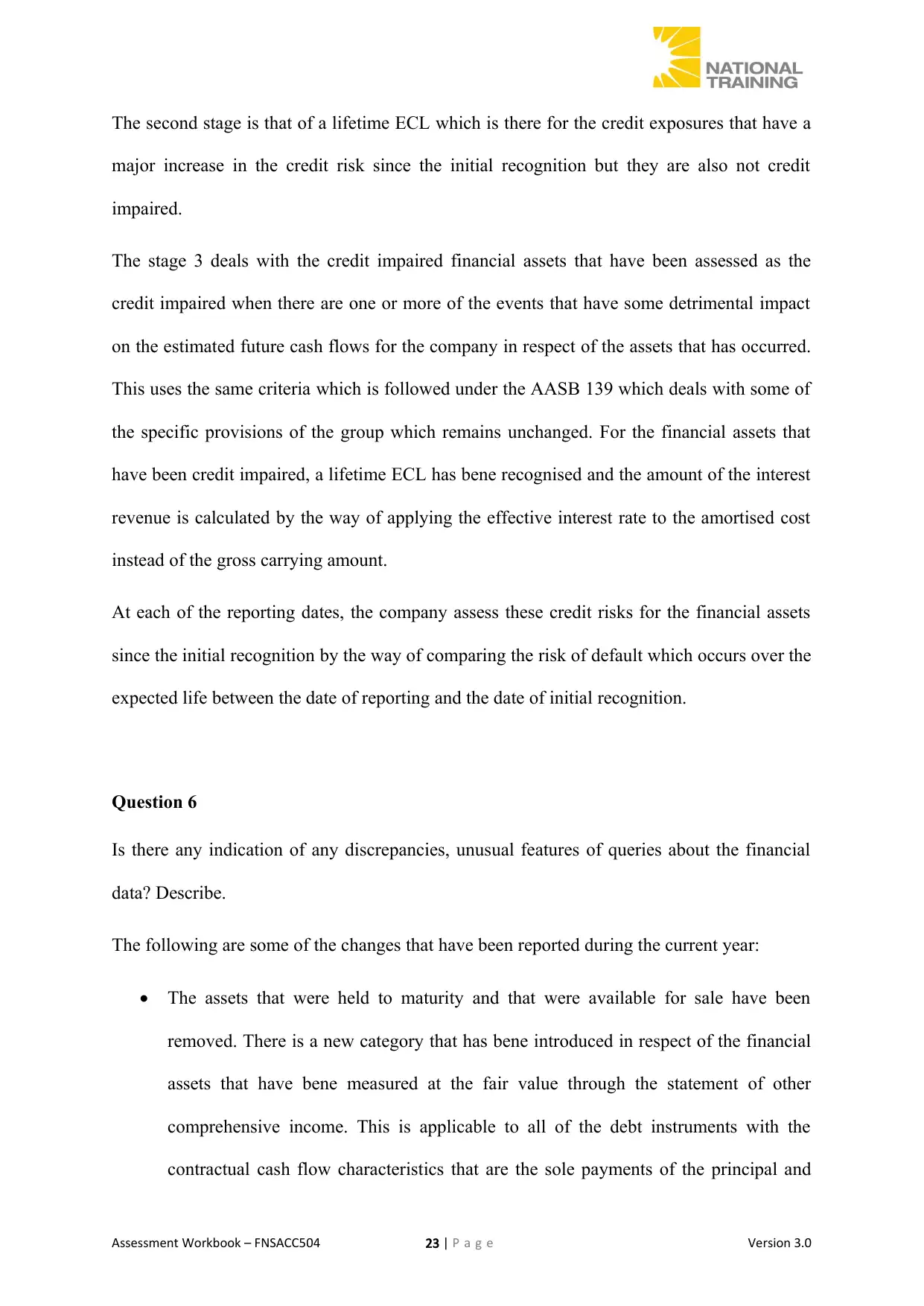
The second stage is that of a lifetime ECL which is there for the credit exposures that have a
major increase in the credit risk since the initial recognition but they are also not credit
impaired.
The stage 3 deals with the credit impaired financial assets that have been assessed as the
credit impaired when there are one or more of the events that have some detrimental impact
on the estimated future cash flows for the company in respect of the assets that has occurred.
This uses the same criteria which is followed under the AASB 139 which deals with some of
the specific provisions of the group which remains unchanged. For the financial assets that
have been credit impaired, a lifetime ECL has bene recognised and the amount of the interest
revenue is calculated by the way of applying the effective interest rate to the amortised cost
instead of the gross carrying amount.
At each of the reporting dates, the company assess these credit risks for the financial assets
since the initial recognition by the way of comparing the risk of default which occurs over the
expected life between the date of reporting and the date of initial recognition.
Question 6
Is there any indication of any discrepancies, unusual features of queries about the financial
data? Describe.
The following are some of the changes that have been reported during the current year:
The assets that were held to maturity and that were available for sale have been
removed. There is a new category that has bene introduced in respect of the financial
assets that have bene measured at the fair value through the statement of other
comprehensive income. This is applicable to all of the debt instruments with the
contractual cash flow characteristics that are the sole payments of the principal and
Assessment Workbook – FNSACC504 23 | P a g e Version 3.0
major increase in the credit risk since the initial recognition but they are also not credit
impaired.
The stage 3 deals with the credit impaired financial assets that have been assessed as the
credit impaired when there are one or more of the events that have some detrimental impact
on the estimated future cash flows for the company in respect of the assets that has occurred.
This uses the same criteria which is followed under the AASB 139 which deals with some of
the specific provisions of the group which remains unchanged. For the financial assets that
have been credit impaired, a lifetime ECL has bene recognised and the amount of the interest
revenue is calculated by the way of applying the effective interest rate to the amortised cost
instead of the gross carrying amount.
At each of the reporting dates, the company assess these credit risks for the financial assets
since the initial recognition by the way of comparing the risk of default which occurs over the
expected life between the date of reporting and the date of initial recognition.
Question 6
Is there any indication of any discrepancies, unusual features of queries about the financial
data? Describe.
The following are some of the changes that have been reported during the current year:
The assets that were held to maturity and that were available for sale have been
removed. There is a new category that has bene introduced in respect of the financial
assets that have bene measured at the fair value through the statement of other
comprehensive income. This is applicable to all of the debt instruments with the
contractual cash flow characteristics that are the sole payments of the principal and
Assessment Workbook – FNSACC504 23 | P a g e Version 3.0
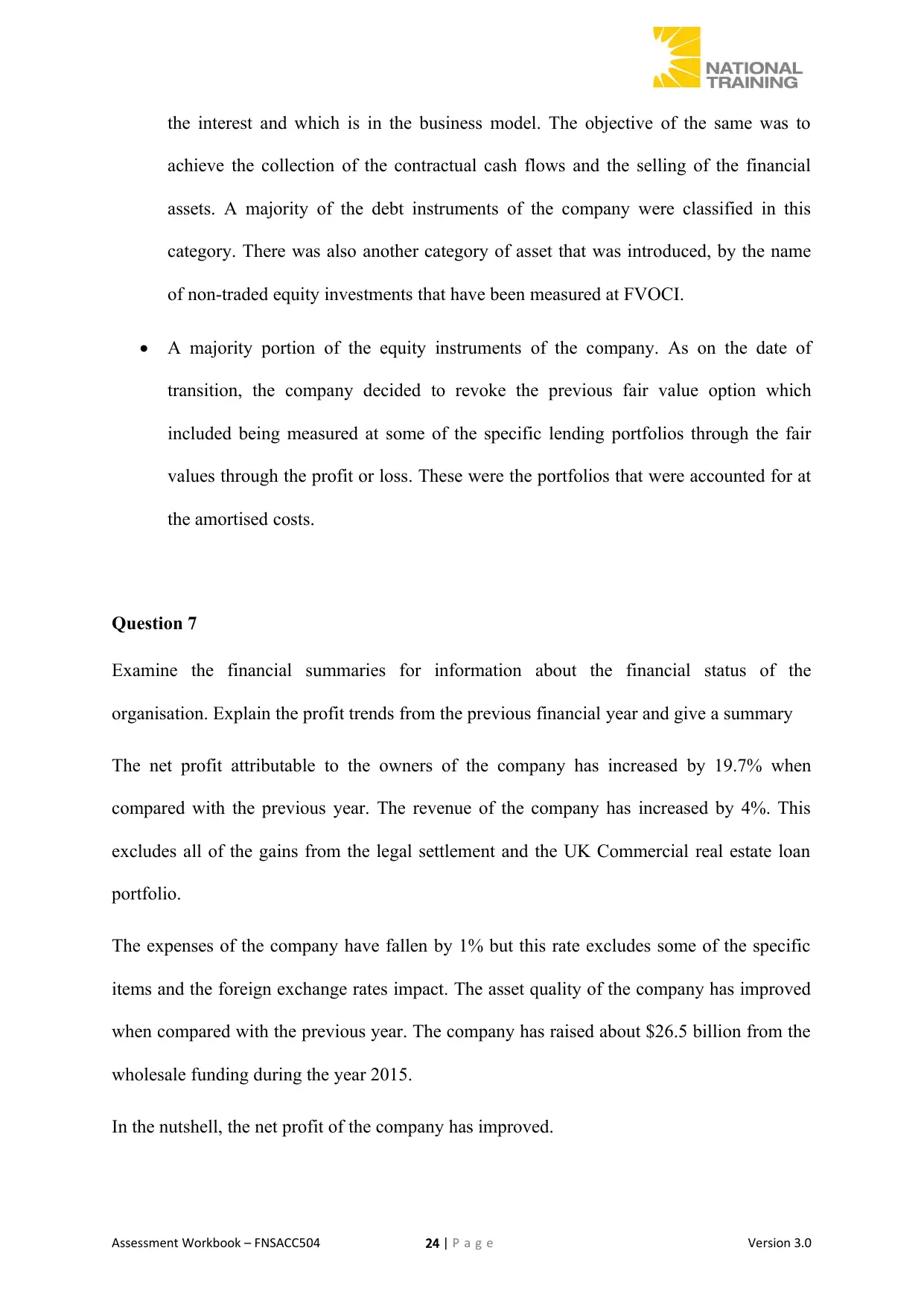
the interest and which is in the business model. The objective of the same was to
achieve the collection of the contractual cash flows and the selling of the financial
assets. A majority of the debt instruments of the company were classified in this
category. There was also another category of asset that was introduced, by the name
of non-traded equity investments that have been measured at FVOCI.
A majority portion of the equity instruments of the company. As on the date of
transition, the company decided to revoke the previous fair value option which
included being measured at some of the specific lending portfolios through the fair
values through the profit or loss. These were the portfolios that were accounted for at
the amortised costs.
Question 7
Examine the financial summaries for information about the financial status of the
organisation. Explain the profit trends from the previous financial year and give a summary
The net profit attributable to the owners of the company has increased by 19.7% when
compared with the previous year. The revenue of the company has increased by 4%. This
excludes all of the gains from the legal settlement and the UK Commercial real estate loan
portfolio.
The expenses of the company have fallen by 1% but this rate excludes some of the specific
items and the foreign exchange rates impact. The asset quality of the company has improved
when compared with the previous year. The company has raised about $26.5 billion from the
wholesale funding during the year 2015.
In the nutshell, the net profit of the company has improved.
Assessment Workbook – FNSACC504 24 | P a g e Version 3.0
achieve the collection of the contractual cash flows and the selling of the financial
assets. A majority of the debt instruments of the company were classified in this
category. There was also another category of asset that was introduced, by the name
of non-traded equity investments that have been measured at FVOCI.
A majority portion of the equity instruments of the company. As on the date of
transition, the company decided to revoke the previous fair value option which
included being measured at some of the specific lending portfolios through the fair
values through the profit or loss. These were the portfolios that were accounted for at
the amortised costs.
Question 7
Examine the financial summaries for information about the financial status of the
organisation. Explain the profit trends from the previous financial year and give a summary
The net profit attributable to the owners of the company has increased by 19.7% when
compared with the previous year. The revenue of the company has increased by 4%. This
excludes all of the gains from the legal settlement and the UK Commercial real estate loan
portfolio.
The expenses of the company have fallen by 1% but this rate excludes some of the specific
items and the foreign exchange rates impact. The asset quality of the company has improved
when compared with the previous year. The company has raised about $26.5 billion from the
wholesale funding during the year 2015.
In the nutshell, the net profit of the company has improved.
Assessment Workbook – FNSACC504 24 | P a g e Version 3.0
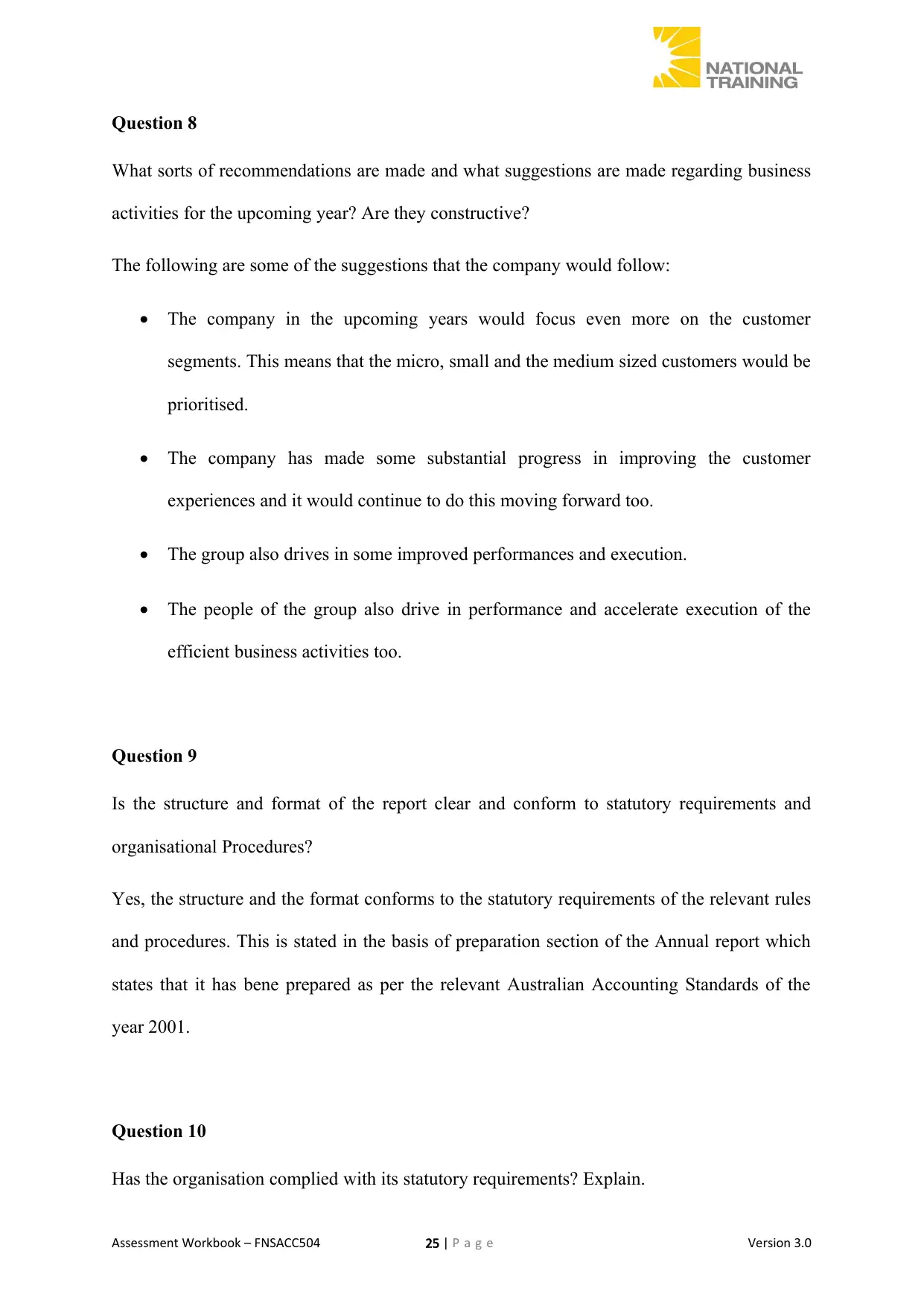
Question 8
What sorts of recommendations are made and what suggestions are made regarding business
activities for the upcoming year? Are they constructive?
The following are some of the suggestions that the company would follow:
The company in the upcoming years would focus even more on the customer
segments. This means that the micro, small and the medium sized customers would be
prioritised.
The company has made some substantial progress in improving the customer
experiences and it would continue to do this moving forward too.
The group also drives in some improved performances and execution.
The people of the group also drive in performance and accelerate execution of the
efficient business activities too.
Question 9
Is the structure and format of the report clear and conform to statutory requirements and
organisational Procedures?
Yes, the structure and the format conforms to the statutory requirements of the relevant rules
and procedures. This is stated in the basis of preparation section of the Annual report which
states that it has bene prepared as per the relevant Australian Accounting Standards of the
year 2001.
Question 10
Has the organisation complied with its statutory requirements? Explain.
Assessment Workbook – FNSACC504 25 | P a g e Version 3.0
What sorts of recommendations are made and what suggestions are made regarding business
activities for the upcoming year? Are they constructive?
The following are some of the suggestions that the company would follow:
The company in the upcoming years would focus even more on the customer
segments. This means that the micro, small and the medium sized customers would be
prioritised.
The company has made some substantial progress in improving the customer
experiences and it would continue to do this moving forward too.
The group also drives in some improved performances and execution.
The people of the group also drive in performance and accelerate execution of the
efficient business activities too.
Question 9
Is the structure and format of the report clear and conform to statutory requirements and
organisational Procedures?
Yes, the structure and the format conforms to the statutory requirements of the relevant rules
and procedures. This is stated in the basis of preparation section of the Annual report which
states that it has bene prepared as per the relevant Australian Accounting Standards of the
year 2001.
Question 10
Has the organisation complied with its statutory requirements? Explain.
Assessment Workbook – FNSACC504 25 | P a g e Version 3.0
Paraphrase This Document
Need a fresh take? Get an instant paraphrase of this document with our AI Paraphraser
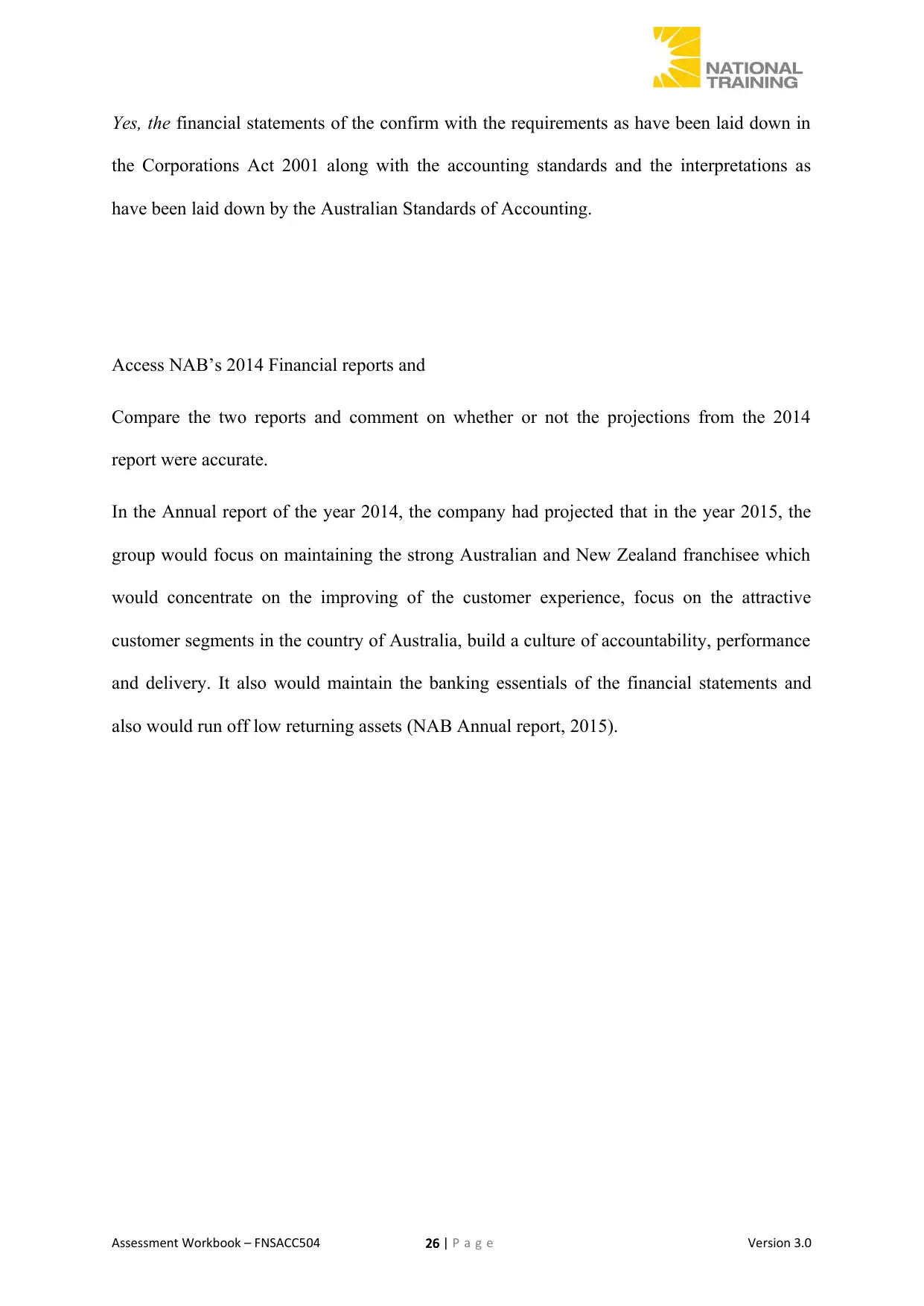
Yes, the financial statements of the confirm with the requirements as have been laid down in
the Corporations Act 2001 along with the accounting standards and the interpretations as
have been laid down by the Australian Standards of Accounting.
Access NAB’s 2014 Financial reports and
Compare the two reports and comment on whether or not the projections from the 2014
report were accurate.
In the Annual report of the year 2014, the company had projected that in the year 2015, the
group would focus on maintaining the strong Australian and New Zealand franchisee which
would concentrate on the improving of the customer experience, focus on the attractive
customer segments in the country of Australia, build a culture of accountability, performance
and delivery. It also would maintain the banking essentials of the financial statements and
also would run off low returning assets (NAB Annual report, 2015).
Assessment Workbook – FNSACC504 26 | P a g e Version 3.0
the Corporations Act 2001 along with the accounting standards and the interpretations as
have been laid down by the Australian Standards of Accounting.
Access NAB’s 2014 Financial reports and
Compare the two reports and comment on whether or not the projections from the 2014
report were accurate.
In the Annual report of the year 2014, the company had projected that in the year 2015, the
group would focus on maintaining the strong Australian and New Zealand franchisee which
would concentrate on the improving of the customer experience, focus on the attractive
customer segments in the country of Australia, build a culture of accountability, performance
and delivery. It also would maintain the banking essentials of the financial statements and
also would run off low returning assets (NAB Annual report, 2015).
Assessment Workbook – FNSACC504 26 | P a g e Version 3.0
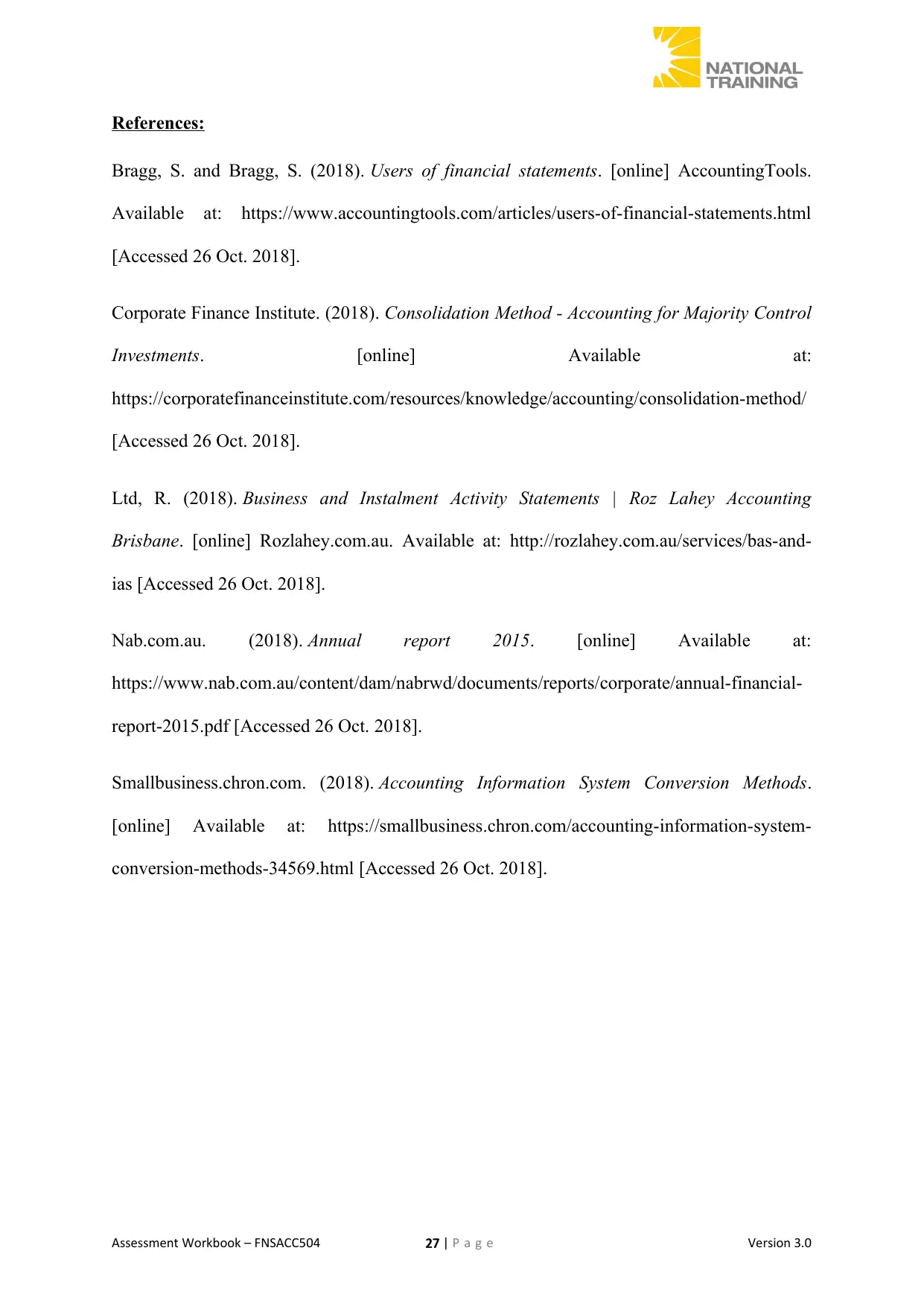
References:
Bragg, S. and Bragg, S. (2018). Users of financial statements. [online] AccountingTools.
Available at: https://www.accountingtools.com/articles/users-of-financial-statements.html
[Accessed 26 Oct. 2018].
Corporate Finance Institute. (2018). Consolidation Method - Accounting for Majority Control
Investments. [online] Available at:
https://corporatefinanceinstitute.com/resources/knowledge/accounting/consolidation-method/
[Accessed 26 Oct. 2018].
Ltd, R. (2018). Business and Instalment Activity Statements | Roz Lahey Accounting
Brisbane. [online] Rozlahey.com.au. Available at: http://rozlahey.com.au/services/bas-and-
ias [Accessed 26 Oct. 2018].
Nab.com.au. (2018). Annual report 2015. [online] Available at:
https://www.nab.com.au/content/dam/nabrwd/documents/reports/corporate/annual-financial-
report-2015.pdf [Accessed 26 Oct. 2018].
Smallbusiness.chron.com. (2018). Accounting Information System Conversion Methods.
[online] Available at: https://smallbusiness.chron.com/accounting-information-system-
conversion-methods-34569.html [Accessed 26 Oct. 2018].
Assessment Workbook – FNSACC504 27 | P a g e Version 3.0
Bragg, S. and Bragg, S. (2018). Users of financial statements. [online] AccountingTools.
Available at: https://www.accountingtools.com/articles/users-of-financial-statements.html
[Accessed 26 Oct. 2018].
Corporate Finance Institute. (2018). Consolidation Method - Accounting for Majority Control
Investments. [online] Available at:
https://corporatefinanceinstitute.com/resources/knowledge/accounting/consolidation-method/
[Accessed 26 Oct. 2018].
Ltd, R. (2018). Business and Instalment Activity Statements | Roz Lahey Accounting
Brisbane. [online] Rozlahey.com.au. Available at: http://rozlahey.com.au/services/bas-and-
ias [Accessed 26 Oct. 2018].
Nab.com.au. (2018). Annual report 2015. [online] Available at:
https://www.nab.com.au/content/dam/nabrwd/documents/reports/corporate/annual-financial-
report-2015.pdf [Accessed 26 Oct. 2018].
Smallbusiness.chron.com. (2018). Accounting Information System Conversion Methods.
[online] Available at: https://smallbusiness.chron.com/accounting-information-system-
conversion-methods-34569.html [Accessed 26 Oct. 2018].
Assessment Workbook – FNSACC504 27 | P a g e Version 3.0
1 out of 27
Your All-in-One AI-Powered Toolkit for Academic Success.
+13062052269
info@desklib.com
Available 24*7 on WhatsApp / Email
![[object Object]](/_next/static/media/star-bottom.7253800d.svg)
Unlock your academic potential
© 2024 | Zucol Services PVT LTD | All rights reserved.